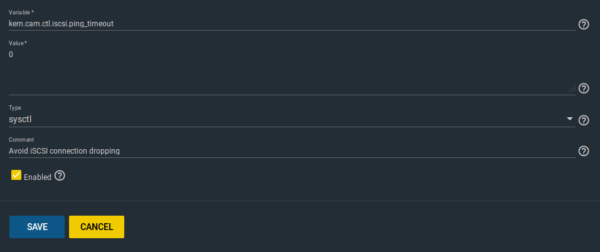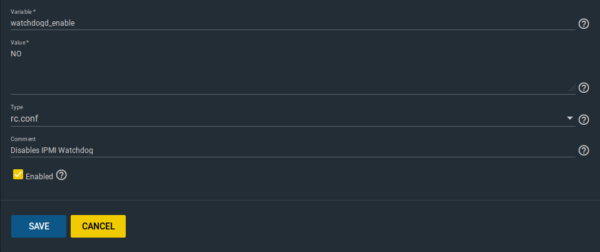
von Ralf Schweiger | März 14, 2020 | Free BSD, Free NAS, Infiniband, Proxmox, Supermicro, Virtualsierung



Performance auf shared iSCSI Storage ist Pflicht, wenn man viele VMs auf einem Proxmox-Cluster betreiben möchte.
Wie sich dabei die einzelnen Protokolle und Implementierungen verhalten, ist hier in der Übersicht zu sehen:

Zeta Systems hat genauestens untersucht, welche Performance aktuell von welchem Protokoll zu erwarten ist:
http://www.zeta.systems/blog/2016/09/21/iSCSI-vs-iSER-vs-SRP-on-Ethernet-&-InfiniBand/
Es soll somit iSER sein. Beschäftigt man sich damit, stellt man fest, dass die Technologie bereits sehr lange existiert, aber scheinbar bisher ein wenig unter gegangen ist.
Eine Präsentation von 2008:
https://www.snia.org/sites/default/orig/sdc_archives/2008_presentations/wednesday/PeterDunlap_OpenSolaris_iSER.pdf
Die Infiniband-Basics auf dem FreeBSD-Wiki:
https://wiki.freebsd.org/InfiniBand
Und hier ein Beitrag von 2016 auf der FreeBSD SCSI Liste:
https://freebsd-scsi.freebsd.narkive.com/sQG1P9kO/help-to-make-iser-working
Hier trägt Ben Rubson das wesentliche zusammen:
Ben RUBSON
4 years ago
Hi,
I went with a fresh new install to have a clean status.
What I did :
// FreeBSD 11-RC1 installation
# echo "WITH_OFED=YES" > /etc/make.conf
# cd /usr/src/ ; make buildkernel KERNCONF=GENERIC ; make installkernel KERNCONF=GENERIC
# cd /usr/src/sys/modules/mlx4 ; make ; make install
# cd /usr/src/sys/modules/mlxen ; make ; make install
# cd /usr/src/sys/modules/iser ; make ; make install
# echo "mlx4_load=YES" >> /boot/loader.conf
# echo "mlxen_load=YES" >> /boot/loader.conf
# echo "iser_load=YES" >> /boot/loader.conf
# reboot
Everything went fine, no code modition needed or whatever, perfect.
# iscsictl -A -t iqn.2012-06.com.test:target1 -p 192.168.2.2
On the target, I get :
tgtd[1912]: tgtd: login_start(502) Target iqn.2012-06.com.test:target1 is RDMA, but conn cid:0 from iqn.1994-09.org.freebsd:srv1 is TCP
Perfect, the target is correctly iSER enabled.
# iscsictl -A -t iqn.2012-06.com.test:target1 -p 192.168.2.2 -r
I still get the following error :
iscsid[1062]: 192.168.2.2 (iqn.2012-06.com.test:target1): failed to connect to 192.168.2.2 using ICL kernel proxy: ISCSIDCONNECT: Input/output error
kernel: INFO: iser_free_ib_conn_res: freeing conn 0xfffff80147771000 cma_id 0 qp 0
kernel: DEBUG: iser_conn_connect: before cv_wait: 0xfffff80147771000
kernel: INFO: iser_cma_handler: event 1 status -19 conn 0xfffff80147771000 id 0xfffff8005f0e5400
kernel: ERROR: iser_connect_error: conn 0xfffff80147771000
kernel: DEBUG: iser_conn_connect: after cv_wait: 0xfffff80147771000
iscsid[853]: child process 1062 terminated with exit status 1
Waiting for your instructions, would really be nice to have it working for 11 release.
Many thanks !
Best regards,
Ben
...
Ben RUBSON
4 years ago
Permalink
...
This was missing :
cd /usr/src/sys/modules/mlx4ib/ ; make ; make install ; kldload mlx4ib.ko
Now it works perfectly...
I'm really sorry for the useless noise on this list...
I hope this above howto will help others.
Thank you again for your support, and sorry again :-/
Benchmarks will of course follow.
Best regards,
Ben
iSer läuft mittlerweile auf FreeBSD, aber eben nicht unter FreeNAS.
Ein Kommentar auf iXsystems Jira lässt hoffen, klar ist das aber nicht:
Kris Moore added a comment - 11/Jan/20 2:53 PM
We're considering some changes this year which may include down
the road iSER support. Closing for now, but stay tuned later
in 2020.
Es sieht also danach aus, dass man sich damit gerade beschäftigt. Ob das Feature aber TrueNAS Core oder TrueNAS Enterprise sein wird, wissen wir nicht.
Daher ist der Weg für uns erst einmal, dass wir das selbst implementieren. Wir brauchen das JETZT, nicht erst im Sommer 2020.
Wie die Story weiter geht, erfahrt Ihr nun.
FreeNAS hat sich bei unseren Tests als nicht gangbar erwiesen.
Problem ist einerseits die ungenügende Mellanox-Unterstützung und andererseits die allgemeine Bestrebung von OSS-Unternehmen, Teile des Codes closed source zu machen und dies als Enterprise-Version zu vermarkten.
Support alleine macht nicht glücklich. Man versucht, dauerhafte Einnahmen zu etablieren, um planbarer zu sein.
Aber zurück zum Thema iSER.
Da Linux eine hervorragende iSER Unterstützung mitbringt und eine der führenden Distributionen sowieso schon im Haus ist, lag es am nahe, zu unseren Proxmox VE Cluster-Knoten auch den restlichen Bereich damit abzudecken: Proxmox iSER/iSCSI-Server, Proxmox Mail Gateway, Proxmox Backupserver.
Proxmox setzen wir auf mit einem ZFS-Pool raidz-1 auf zwei gespiegelten Intel NVMe SSD DC P4511 mit je 900GB. Das hätte es zwar nicht gebraucht, aber die lagen noch im Regal.
Erster Schritt, evtl. noch vorhandene ZFS-Metadaten löschen, und zwar am Ende und am Anfang der Platten.
dd bs=512 if=/dev/zero of=/dev/nvme0n1 count=2048 seek=$(($(blockdev --getsz /dev/nvme0n1) - 2048))
dd bs=512 if=/dev/zero of=/dev/nvme0n1 count=2048
dd bs=512 if=/dev/zero of=/dev/nvme1n1 count=2048 seek=$(($(blockdev --getsz /dev/nvme1n1) - 2048))
dd bs=512 if=/dev/zero of=/dev/nvme1n1 count=2048
Nach Erstinstallation bootet das System aber nicht.
Ok., Proxmox VE im Debug Modus starten, dabei stoppt das System an mehreren Stellen, was man mit exit weiter laufen lässt. Am Ende hat man eine root Shell mit allen notwendigen Werkzeugen.
Ein „zpool import“ offenbart, dass der Pool online ist.
Weiterhin lässt er sich problemlos importieren und mounten.
mkdir /mnt/rpool
zpool import -R /mnt/rpool rpool
zpool export
Das Problem war hier der BIOS legacy mode.
Nach einem „zpool destroy -f rpool“, Umstellung auf UEFI und Neuinstallation mit UEFI-Boot von Proxmox VE 6.4, war das Boot-Problem behoben.
Basisinstallation iSCSI/Infiniband Tools, opensm Infiniband Subnet Manager, NFS-Server und targetcli-fb zum managen von iSER Devices:
apt-get install apt-file net-tools opensm nfs-kernel-server rtr-tools scsitools scsitools targetcli-fb librdmacm1 ibacm infiniband-diags srptools vim ibutils ibverbs-providers ibverbs-utils rdmacm-utils perftest tgt open-iscsi lsscsi tgt multipath-tools -y
apt-file update
Anlegen der /etc/rc.local mit folgendem Inhalt:
#!/bin/sh -e
#
# rc.local
#
# This script is executed at the end of each multiuser runlevel.
# Make sure that the script will "exit 0" on success or any other
# value on error.
#
# In order to enable or disable this script just change the execution
# bits.
#
# By default this script does nothing.
# run at startup
echo 0 > /proc/sys/kernel/hung_task_timeout_secs
/usr/local/bin/iser-performance-tuning.sh
exit 0
Anlegen des iser-performance-tuning.sh Skripts /usr/local/bin/iser-performance-tuning.sh:
#!/bin/bash
target=pvecn0
verbose=0
messenger(){
if [ "$verbose" = "1" ]
then printf "$MSG\n"
fi
}
# iSER LIO server is target, clients are initiators
if [ "$(hostname)" = "$target" ]
then iSERtype="target"
else iSERtype="initiator"
fi
MSG="iSER type is:\t$iSERtype"
messenger
irq_affinity(){
#relevant for target and initiator
MSG="IRQ affinity setup..."
messenger
#service irqbalancer stop 2>&1>/dev/null
IRQS=$(cat /proc/interrupts | egrep 'mlx4|mlx5' | awk '{print $1}' | sed 's/://')
cores=($(seq 1 $(grep -c processor /proc/cpuinfo)))
i=0
#echo ${#cores[@]}
for IRQ in $IRQS
do
core=${cores[$i]}
let "mask=2**(core-1)"
#printf "IRQ\t:\t$IRQ\nIndex\t:\t$i\ncore\t:\t$core\nmask\t:\t$mask\n"
echo $(printf "%x" $mask) > /proc/irq/$IRQ/smp_affinity
i=$(($i+1))
if [ "$i" = "${#cores[@]}" ]; then i=0
fi
done
}
cpu_performance_scaling(){
# relevant for target and initiator
MSG="CPU performance setup..."
messenger
for i in $(ls /sys/devices/system/cpu/cpu[0-9]*/cpufreq/scaling_governor | sed -e "s/ /\n/g")
{
echo performance >$i
}
}
block_layer_staging(){
# relevant for initiators only
MSG="Block layer staging..."
messenger
# set IO scheduler to do no-operation.
# IO schedulers try to accelerate HDD access time by minimizing seeks.
# When working with SAN targets normally it is better to let the target machine do these optimizations if needed (normally a single LUN is not made of a single HDD...).
#In addition, SDDs do not suffer from seek time.
for i in $(ls /sys/block/[a-z]*/queue/scheduler)
{
echo "noop" >$i 2>&1>/dev/null
}
# Normally the block layer will try to merge IOs to consecutive offsets.
# On fast SAN networks it may be better not to merge, and save the CPU utilization.
for i in $(ls /sys/block/[a-z]*/queue/nomerges)
{
echo 2 >$i
}
# The system uses physical devices to gather randomness for its random numbers generator.
# Can save some utilization by turning this off.
for i in $(ls /sys/block/[a-z]*/queue/add_random)
{
echo 0 >$i
}
# Deliver IO completion on the same core that handled the request.
for i in $(ls /sys/block/[a-z]*/queue/rq_affinity)
{
echo 1 >$i
}
}
set_nv_huge_pages(){
# relevant for targets only
MSG="Huge paging setup..."
messenger
# In case of kernel space target suech as LIO or SCST, set a low (or zero) number of HugePages (Increases page-cache)
echo 0 > /proc/sys/vm/nr_hugepages
}
if [ "$iSERtype" = "target" ]
then
MSG="Running target optimizations..."
messenger
irq_affinity
cpu_performance_scaling
set_nv_huge_pages
fi
if [ "$iSERtype" = "initiator" ]
then
MSG="Running initiator optimizations..."
messenger
irq_affinity
cpu_performance_scaling
block_layer_staging
fi
Anlegen von /usr/local/bin/iscsi-autologin.sh:
#!/bin/bash
### enable autologin to iSCSI target ###
iscsiadm --mode node -T iqn.2020-03.de.pawott.pvecn0.hddpool -o update -n node.startup -v automatic
iscsiadm --mode node -T iqn.2020-03.de.pawott.pvecn0.ssdpool -o update -n node.startup -v automatic
cd /etc/iscsi
grep -R node.startup * | grep -v manual
SSH-Keys id_rsa und id_rsa.pub erzeugen und verteilen auf alle Knoten nach
/root/.ssh/
/etc/pve/priv/authorized_keys
Einstellungen für remote shell
/root/.bashrc
# ~/.bashrc: executed by bash(1) for non-login shells.
# If not running interactively, don't do anything
case $- in
*i*) ;;
*) return;;
esac
# Note: PS1 and umask are already set in /etc/profile. You should not
# need this unless you want different defaults for root.
# PS1='${debian_chroot:+($debian_chroot)}\h:\w\$ '
# umask 022
# You may uncomment the following lines if you want `ls' to be colorized:
# export LS_OPTIONS='--color=auto'
# eval "`dircolors`"
alias ls='ls $LS_OPTIONS'
alias ll='ls $LS_OPTIONS -l'
alias l='ls $LS_OPTIONS -lA'
#
# Some more alias to avoid making mistakes:
# alias rm='rm -i'
# alias cp='cp -i'
# alias mv='mv -i'
if [ -f ~/.bash_aliases ]; then
. ~/.bash_aliases
fi
if [ -f /etc/bash.bashrc.local ]; then
. /etc/bash.bashrc.local
fi
Farbcodes in Ausgaben:
/etc/rc.status
# Definition of boot script return messages
#
# The bootscripts should use the variables rc_done and rc_failed to
# report whether they failed or succeeded. See /etc/init.d/skeleton for
# an example how the shell functions rc_status and rc_reset are used.
#
# These functions make use of the variables rc_done and rc_failed;
# rc_done_up and rc_failed_up are the same as rc_done and rc_failed
# but contain a terminal code to move up one line before the output
# of the actual string. (This is particularly useful when the script
# starts a daemon which produces user output with a newline character)
#
# The variable rc_reset is used by the master resource control script
# /etc/init.d/rc to turn off all attributes and switch to the standard
# character set.
#
# \033 ascii ESCape
# \033[G move to column (linux console, xterm, not vt100)
# \033[C move columns forward but only upto last column
# \033[D move columns backward but only upto first column
# \033[A move rows up
# \033[B move rows down
# \033[1m switch on bold
# \033[31m switch on red
# \033[32m switch on green
# \033[33m switch on yellow
# \033[m switch off color/bold
# \017 exit alternate mode (xterm, vt100, linux console)
# \033[10m exit alternate mode (linux console)
# \015 carriage return (without newline)
if test -z "$LINES" -o -z "$COLUMNS" ; then
eval `exec 3<&1; stty size <&3 2>/dev/null | (read L C; \
echo LINES=${L:-24} COLUMNS=${C:-80})`
fi
test $LINES -eq 0 && LINES=24
test $COLUMNS -eq 0 && COLUMNS=80
export LINES COLUMNS
# Make sure we have /sbin and /usr/sbin in PATH
case $PATH in
*sbin*)
;;
*)
export PATH=/sbin:/usr/sbin:$PATH
;;
esac
if test -t 1 -a "$TERM" != "raw" -a "$TERM" != "dumb" && stty size <&1 > /dev/null 2>&1 ; then
esc=`echo -en "\033"`
extd="${esc}[1m"
warn="${esc}[1;31m"
done="${esc}[1;32m"
attn="${esc}[1;33m"
norm=`echo -en "${esc}[m\017"`
stat=`echo -en "\015${esc}[${COLUMNS}C${esc}[10D"`
rc_done="${stat}${done}done${norm}"
rc_running="${stat}${done}running${norm}"
rc_failed="${stat}${warn}failed${norm}"
rc_missed="${stat}${warn}missing${norm}"
rc_skipped="${stat}${attn}skipped${norm}"
rc_dead="${stat}${warn}dead${norm}"
rc_unused="${stat}${extd}unused${norm}"
rc_unknown="${stat}${attn}unknown${norm}"
rc_done_up="${esc}[1A${rc_done}"
rc_failed_up="${esc}[1A${rc_failed}"
rc_reset="${norm}${esc}[?25h"
rc_save="${esc}7${esc}[?25l"
rc_restore="${esc}8${esc}[?25h"
function rc_cuu () { test $1 -eq 0 && return; echo -en "\033[${1}A"; }
function rc_cud () { test $1 -eq 0 && return; echo -en "\033[${1}B"; }
function rc_timer_on () {
# Draw seconds of running timout to column.
# Two arguments: timeout in seconds and offset
local n=$1
local c=$2
(trap "exit 0" TERM
while test $((n--)) -gt 0; do
sleep 1;
if test $n -gt 9 ; then
echo -en "${attn}\015${esc}[${c}C(${n}s)${norm} "
else
echo -en "${attn}\015${esc}[${c}C( ${n}s)${norm} "
fi
done) & _rc_timer_pid=$!
}
function rc_timer_off () {
if test -n "$_rc_timer_pid" ; then
kill -TERM $_rc_timer_pid > /dev/null 2>&1
fi
unset _rc_timer_pid
}
else
esc=""
extd=""
warn=""
done=""
attn=""
norm=""
stat=""
rc_done="..done"
rc_running="..running"
rc_failed="..failed"
rc_missed="..missing"
rc_skipped="..skipped"
rc_dead="..dead"
rc_unused="..unused"
rc_unknown="..unknown"
rc_done_up="${rc_done}"
rc_failed_up="${rc_failed}"
rc_reset=""
rc_save=""
rc_restore=""
function rc_cuu () { return; }
function rc_cud () { return; }
function rc_timer_on () { return; }
function rc_timer_off () { return; }
fi
_rc_service=${0##*/[SK][0-9][0-9]}
_rc_status=0
_rc_status_all=0
_rc_todo=$1
function rc_check ()
{
_rc_status_ret=$?
test $_rc_status_ret -eq 0 || _rc_status=$_rc_status_ret
test $_rc_status -eq 0 || _rc_status_all=$_rc_status
return $_rc_check_ret
}
function rc_reset ()
{
_rc_status=0
_rc_status_all=0
rc_check
return 0
}
if test "$_rc_todo" = "status" ; then
function rc_status ()
{
rc_check
_rc_status_ret=$_rc_status
local i
for i ; do
case "$i" in
-v|-v[1-9]|-v[1-9][0-9])
local vrt=""
local out=1
local opt="en"
test -n "${i#-v}" && vrt="$vrt${esc}[${i#-v}A" || opt="e"
case "$_rc_status" in
0) vrt="$vrt$rc_running"; ;; # service running
1) vrt="$vrt$rc_dead" ; out=2 ;; # service dead (but has pid file)
2) vrt="$vrt$rc_dead" ; out=2 ;; # service dead (but has lock file)
3) vrt="$vrt$rc_unused" ; ;; # service not running
4) vrt="$vrt$rc_unknown"; ;; # status is unknown
esac
echo -$opt "$rc_save$vrt$rc_restore" 1>&$out
# reset _rc_status to 0 after verbose case
_rc_status=0 ;;
-r) rc_reset ;;
-s) echo -e "$rc_skipped" ; rc_failed 3 ;;
-u) echo -e "$rc_unused" ; rc_failed 3 ;;
*) echo "rc_status: Usage: [-v[] [-r]|-s|-u]" 1>&2 ; return 0 ;;
esac
done
return $_rc_status_ret
}
elif test -n "$_rc_todo" ; then
function rc_status ()
{
rc_check
test "$_rc_status" -gt 7 && rc_failed 1
_rc_status_ret=$_rc_status
case "$_rc_todo" in
stop)
# program is not running which
# is success if we stop service
test "$_rc_status" -eq 7 && rc_failed 0 ;;
esac
local i
for i ; do
case "$i" in
-v|-v[1-9]|-v[1-9][0-9])
local vrt=""
local out=1
local opt="en"
test -n "${i#-v}" && vrt="$vrt${esc}[${i#-v}A" || opt="e"
case "$_rc_status" in
0) vrt="$vrt$rc_done" ; ;; # success
1) vrt="$vrt$rc_failed" ; out=2 ;; # generic or unspecified error
2) vrt="$vrt$rc_failed" ; out=2 ;; # invalid or excess args
3) vrt="$vrt$rc_missed" ; out=2 ;; # unimplemented feature
4) vrt="$vrt$rc_failed" ; out=2 ;; # insufficient privilege
5) vrt="$vrt$rc_skipped"; out=2 ;; # program is not installed
6) vrt="$vrt$rc_unused" ; out=2 ;; # program is not configured
7) vrt="$vrt$rc_failed" ; out=2 ;; # program is not running
*) vrt="$vrt$rc_failed" ; out=2 ;; # unknown (maybe used in future)
esac
echo -$opt "$rc_save$vrt$rc_restore" 1>&$out
# reset _rc_status to 0 after verbose case
_rc_status=0 ;;
-r) rc_reset ;;
-s) echo -e "$rc_skipped" 1>&2 ; rc_failed 5 ;;
-u) echo -e "$rc_unused" 1>&2 ; rc_failed 6 ;;
*) echo "rc_status: Usage: [-v[] [-r]|-s|-u]" 1>&2 ; return 0 ;;
esac
done
return $_rc_status_ret
}
else
function rc_status ()
{
rc_check
_rc_status_ret=$_rc_status
local i
for i ; do
case "$i" in
-v|-v[1-9]|-v[1-9][0-9])
local vrt=""
local out=1
local opt="en"
test -n "${i#-v}" && vrt="$vrt${esc}[${i#-v}A" || opt="e"
case "$_rc_status" in
0) vrt="$vrt$rc_done" ; ;; # success
*) vrt="$vrt$rc_failed"; out=2 ;; # failed
esac
echo -$opt "$rc_save$vrt$rc_restore" 1>&$out
# reset _rc_status to 0 after verbose case
_rc_status=0 ;;
-r) rc_reset ;;
-s) echo -e "$rc_skipped" ; return 0 ;;
-u) echo -e "$rc_unused" ; return 0 ;;
*) echo "rc_status: Usage: [-v[] [-r]|-s|-u]" 1>&2 ; return 0 ;;
esac
done
return $_rc_status_ret
}
fi
function rc_failed ()
{
rc_reset
case "$1" in
[0-7]) _rc_status=$1 ;;
"") _rc_status=1
esac
rc_check
return $_rc_status
}
function rc_exit ()
{
exit $_rc_status_all
}
function rc_confirm()
{
local timeout="30"
local answer=""
local ret=0
case "$1" in
-t) timeout=$2; shift 2 ;;
esac
local message="$@, (Y)es/(N)o/(C)ontinue? [y] "
: ${REDIRECT:=/dev/tty}
while true ; do
read -t ${timeout} -n 1 -p "${message}" answer < $REDIRECT > $REDIRECT 2>&1
case "$answer" in
[yY]|"") ret=0; break ;;
[nN]) ret=1; break ;;
[cC]) ret=2; break ;;
*) echo; continue
esac
done
echo
return $ret
}
function rc_active ()
{
local x
for x in /etc/init.d/*.d/S[0-9][0-9]${1} ; do
test -e $x || break
return 0
done
return 1
}
function rc_splash()
{
return 0
}
Lokale globale /etc/bash.bashrc.local
# bash completion for the `wp` command
_wp_complete() {
local OLD_IFS="$IFS"
local cur=${COMP_WORDS[COMP_CWORD]}
IFS=$'\n'; # want to preserve spaces at the end
local opts="$(wp cli completions --line="$COMP_LINE" --point="$COMP_POINT")"
if [[ "$opts" =~ \<file\>\s* ]]
then
COMPREPLY=( $(compgen -f -- $cur) )
elif [[ $opts = "" ]]
then
COMPREPLY=( $(compgen -f -- $cur) )
else
COMPREPLY=( ${opts[*]} )
fi
IFS="$OLD_IFS"
return 0
}
complete -o nospace -F _wp_complete wp
if [ "$PS1" ]; then
PS1='\u@\h:\w\$ '
ROTH="\[\033[1;31m\]"
ROT="\[\033[0;31m\]"
GRUEN="\[\033[0;32m\]"
BLAU="\[\033[0;34m\]"
YELLOW="\[\033[1;33m\]"
NOCOLOR="\[\033[0m\]"
[ "$UID" == "0" ] && USRCLR="$ROT\\u$NOCOLOR" || USRCLR="\\u"
PS1="${ROTH}Remote: $GRUEN\$(date +%H:%M:%S)h$ROTH@$YELLOW\h ${BLAU}[$GRUEN$USRCLR$ROTH@$ROTH${debian_chroot:+($debian_chroot)}$GRUEN\w${BLAU}]\n$NOCOLOR#"
shopt -s checkwinsize
# You may uncomment the following lines if you want `ls' to be colorized:
export LS_OPTIONS='--color=auto'
eval "`dircolors`"
alias ls='ls $LS_OPTIONS'
alias ll='ls $LS_OPTIONS -l'
alias l='ls $LS_OPTIONS -lA'
alias mce='mcedit'
if [ -f /etc/bash_completion ]; then
. /etc/bash_completion
fi
if [ -f /etc/bash.aliases ]; then
. /etc/bash.aliases
fi
export LANG=de_DE.UTF-8
. /etc/rc.status
echo -en "\033[1m"
echo "${done}"
echo "UPTIME / SYSINFOS :"
echo ""
echo "___________________________________________________________________________"
echo ""
uptime
echo -en "\033[1m"
echo "___________________________________________________________________________"
echo "${norm}"
/usr/local/bin/checkspace
echo ""
echo -en "\033[1m"
fi
if [ $UID != 0 ]
then
echo ""
echo -en "\033[1m"
echo -en "\033[34m"
cal
echo -en "${done}"
else
echo -en "\033[0;31m"
echo "_________________________"
echo "| |"
echo "| root weiss was er tut! |"
echo "|________________________|"
echo ""
fi
export HISTTIMEFORMAT='%F %T '
export HISTSIZE=150000
export HISTSIZEFILE=150000
export LANG=de_DE.UTF-8
export LANGUAGE=
export LC_CTYPE="de_DE.UTF-8"
export LC_NUMERIC="de_DE.UTF-8"
export LC_TIME="de_DE.UTF-8"
export LC_COLLATE="de_DE.UTF-8"
export LC_MONETARY="de_DE.UTF-8"
export LC_MESSAGES="de_DE.UTF-8"
export LC_PAPER="de_DE.UTF-8"
export LC_NAME="de_DE.UTF-8"
export LC_ADDRESS="de_DE.UTF-8"
export LC_TELEPHONE="de_DE.UTF-8"
export LC_MEASUREMENT="de_DE.UTF-8"
export LC_IDENTIFICATION="de_DE.UTF-8"
export LC_ALL="de_DE.UTF-8"
Anpassung locale:
sed -i "s/# de_DE.UTF-8 UTF-8/de_DE.UTF-8 UTF-8/" /etc/locale.gen
locale-gen
Falls beim SSH login folgende Meldung auftaucht:
Offending key for IP in /home/${user}/.ssh/known_hosts:220
oder
Offending key for IP in /etc/ssh/ssh_known_hosts:8
ist folgendes zu tun:
sed -i '220d' ~/.ssh/known_host
bzw.
sed -i '8d' /etc/ssh/ssh_known_hosts
Notwendige Kernel-Module Client, ib_isert würde nicht benötigt, wird aber dennoch mit geladen:
mlx4_en 118784 0
mlx4_ib 196608 0
ib_uverbs 126976 32 mlx4_ib,rdma_ucm
ib_core 311296 13 rdma_cm,ib_ipoib,rpcrdma,mlx4_ib,ib_srp,iw_cm,ib_iser,ib_umad,ib_isert,rdma_ucm,ib_uverbs,ib_cm
mlx4_core 307200 2 mlx4_ib,mlx4_en
Notwendige Kernel-Module Server:
mlx4_en 118784 0
mlx4_ib 196608 0
ib_uverbs 126976 32 mlx4_ib,rdma_ucm
ib_core 311296 13 rdma_cm,ib_ipoib,rpcrdma,mlx4_ib,ib_srp,iw_cm,ib_iser,ib_umad,ib_isert,rdma_ucm,ib_uverbs,ib_cm
mlx4_core 307200 2 mlx4_ib,mlx4_en
Interfaces /etc/network/interfaces, je Mellanox Infiniband ein eigenes Subnetz:
# network interface settings; autogenerated
# Please do NOT modify this file directly, unless you know what
# you're doing.
#
# If you want to manage parts of the network configuration manually,
# please utilize the 'source' or 'source-directory' directives to do
# so.
# PVE will preserve these directives, but will NOT read its network
# configuration from sourced files, so do not attempt to move any of
# the PVE managed interfaces into external files!
auto lo
iface lo inet loopback
iface eno3 inet manual
iface eno1 inet manual
iface eno4 inet manual
iface eno2 inet manual
auto bond0
iface bond0 inet manual
bond-slaves eno1 eno2
bond-miimon 100
bond-mode 802.3ad
bond-xmit-hash-policy layer3+4
#SFP+ Bond
auto vmbr1
iface vmbr1 inet static
address 10.40.2.100/24
bridge-ports eno3
bridge-stp off
bridge-fd 0
# gateway 10.40.2.1
#Proxmox INFRASTRUCTURE/FAILOVER1
auto vmbr0
iface vmbr0 inet static
address 10.40.0.100/24
bridge-ports bond0
bridge-stp off
bridge-fd 0
bridge-vlan-aware yes
bridge-vids 2-4094
#Bonding Bridge VMs
auto vmbr1:0
iface vmbr1:0 inet static
address 192.168.0.100/24
gateway 192.168.0.1
#Temporary IP alias
auto vmbr2
iface vmbr2 inet static
address 10.40.7.100/24
bridge-ports eno4
bridge-stp off
bridge-fd 0
#Proxmox FAILOVER2
auto ibp3s0
iface ibp3s0 inet static
address 10.40.10.100/24
pre-up echo connected > /sys/class/net/ibp3s0/mode
post-up /usr/sbin/ip link set ibp3s0 mtu 4092
post-up echo 1 > /proc/sys/net/ipv4/conf/all/arp_ignore
post-up echo 2 > /proc/sys/net/ipv4/conf/all/arp_announce
post-up echo 1 > /proc/sys/net/ipv4/conf/ibp3s0/arp_ignore
auto ibp4s0
iface ibp4s0 inet static
address 10.40.20.100/24
pre-up echo connected > /sys/class/net/ibp4s0/mode
post-up /usr/sbin/ip link set ibp4s0 mtu 4092
post-up echo 1 > /proc/sys/net/ipv4/conf/all/arp_ignore
post-up echo 2 > /proc/sys/net/ipv4/conf/all/arp_announce
post-up echo 1 > /proc/sys/net/ipv4/conf/ibp4s0/arp_ignore
auto ibp3s0d1
iface ibp3s0d1 inet static
address 10.40.30.100/24
pre-up echo connected > /sys/class/net/ibp3s0d1/mode
post-up /usr/sbin/ip link set ibp3s0d1 mtu 4092
post-up echo 1 > /proc/sys/net/ipv4/conf/all/arp_ignore
post-up echo 2 > /proc/sys/net/ipv4/conf/all/arp_announce
post-up echo 1 > /proc/sys/net/ipv4/conf/ibp3s0d1/arp_ignore
auto ibp4s0d1
iface ibp4s0d1 inet static
address 10.40.40.100/24
pre-up echo connected > /sys/class/net/ibp4s0d1/mode
post-up /usr/sbin/ip link set ibp4s0d1 mtu 4092
post-up echo 1 > /proc/sys/net/ipv4/conf/all/arp_ignore
post-up echo 2 > /proc/sys/net/ipv4/conf/all/arp_announce
post-up echo 1 > /proc/sys/net/ipv4/conf/ibp4s0d1/arp_ignore
Einträge in /etc/hosts aller Cluster-Knoten, um unnötige DNS-Abfragen zu vermeiden:
127.0.0.1 localhost.localdomain localhost
10.40.2.100 pvecn0.pawott.de pvecn0
10.40.2.101 pvecn1.pawott.de pvecn1
10.40.2.102 pvecn2.pawott.de pvecn2
10.40.2.103 pvecn3.pawott.de pvecn3
10.40.2.104 pvecn4.pawott.de pvecn4
10.40.2.105 pvecn5.pawott.de pvecn5
10.40.2.106 pvecn6.pawott.de pvecn6
10.40.10.100 iscsi-portal.pawott.de iscsi-portal
10.40.20.100 iscsi-portal.pawott.de iscsi-portal
#10.40.30.100 iscsi-portal1.pawott.de iscsi-portal1
#10.40.20.100 iscsi-portal2.pawott.de iscsi-portal2
# The following lines are desirable for IPv6 capable hosts
::1 ip6-localhost ip6-loopback
fe00::0 ip6-localnet
ff00::0 ip6-mcastprefix
ff02::1 ip6-allnodes
ff02::2 ip6-allrouters
ff02::3 ip6-allhosts
Anlegen der /etc/modules-load.d/mellanox.conf zum Laden der Module:
mlx4_core
mlx4_ib
mlx4_en
ib_core
#ib_addr
#ib_sa
ib_cm
rdma_cm
rdma_ucm
ib_iser
#ib_isert
## IP over Infiniband
ib_ipoib
ib_umad
#ib_mad
rpcrdma
ib_srp
ib_isert
iw_cm
ib_uverbs
svcrdma
xprtrdma
Aktivierung von iSCSI über RDMA in /etc/rdma/modules/rdma.conf
# These modules are loaded by the system if any RDMA devices is installed
# iSCSI over RDMA client support
ib_iser
# iSCSI over RDMA target support
ib_isert
# User access to RDMA verbs (supports libibverbs)
ib_uverbs
# User access to RDMA connection management (supports librdmacm)
rdma_ucm
# RDS over RDMA support
# rds_rdma
# NFS over RDMA client support
xprtrdma
# NFS over RDMA server support
svcrdma
Port Typ Konfiguration:
for i in $(lspci | grep Mellanox | awk '{print $1}'); { echo "0000:$i ib ib" >>/etc/rdma/mlx4.conf; }
Deaktivierung von i40iw Devices in /etc/modprobe.d/mlx4.conf:
echo "blacklist i40iw" >> /etc/modprobe.d/mlx4.conf
Aktivieren der Exports des NFS-Server unter /etc/exports:
# /etc/exports: the access control list for filesystems which may be exported
# to NFS clients. See exports(5).
#
# Example for NFSv2 and NFSv3:
# /srv/homes hostname1(rw,sync,no_subtree_check) hostname2(ro,sync,no_subtree_check)
#
# Example for NFSv4:
# /srv/nfs4 gss/krb5i(rw,sync,fsid=0,crossmnt,no_subtree_check)
# /srv/nfs4/homes gss/krb5i(rw,sync,no_subtree_check)
#
/hddpool/NFS/ISO-Images 10.40.2.0/24(rw,no_root_squash,no_all_squash,sync,no_subtree_check)
/hddpool/NFS/ISO-Images 10.40.2.50(rw,no_root_squash,no_all_squash,sync,no_subtree_check)
/hddpool/NFS/ISO-Images 10.40.10.0/24(rw,no_root_squash,no_all_squash,sync,no_subtree_check)
/hddpool/NFS/ISO-Images 10.40.20.0/24(rw,no_root_squash,no_all_squash,sync,no_subtree_check)
/hddpool/NFS/ISO-Images 10.40.30.0/24(rw,no_root_squash,no_all_squash,sync,no_subtree_check)
/hddpool/NFS/ISO-Images 10.40.40.0/24(rw,no_root_squash,no_all_squash,sync,no_subtree_check)
/hddpool/NFS/Snapshots 10.40.2.0/24(rw,no_root_squash,no_all_squash,sync,no_subtree_check)
/hddpool/NFS/Snapshots 10.40.2.50(rw,no_root_squash,no_all_squash,sync,no_subtree_check)
/hddpool/NFS/Snapshots 10.40.10.0/24(rw,no_root_squash,no_all_squash,sync,no_subtree_check)
/hddpool/NFS/Snapshots 10.40.20.0/24(rw,no_root_squash,no_all_squash,sync,no_subtree_check)
/hddpool/NFS/Snapshots 10.40.30.0/24(rw,no_root_squash,no_all_squash,sync,no_subtree_check)
/hddpool/NFS/Snapshots 10.40.40.0/24(rw,no_root_squash,no_all_squash,sync,no_subtree_check)

von Ralf Schweiger | Mai 15, 2019 | Bareos-Server, Debian, Free BSD, Free NAS, Hardware, Infiniband, Linux, Virtualsierung
Wenn Proxmox im Cluster laufen soll, benötigt es ein shared storage. Das kann NFS sein oder besser iSCSI. Für Performance ist letztendlich entscheidend das Layout des Storage-Pools und eine möglichst latenzarme Anbindung. Fiberchannel oder Infiniband sind hier die Kandidaten der Wahl. Letzteres hat allerdings die Nase vorn, wenn es um Bandbreite geht und es ist ausgereift, da es im High-Perfomance-Computing schon sehr lange im Einsatz ist. Infiniband kennen wir zudem aus dem HP POD Supercomputing Projekt bei Airbus (damals die Nr.10 auf top500.org).
Da die Auswahl an Storage-Systemen mit Infiniband-Unterstützung dünn und im bezahlbaren Bereich quasi nicht vorhanden ist, haben wir beschlossen, selbst ein Storage zu entwickeln.
Als Hardware-Basis für Storage, Virtualisierungsplattform und Backup dienen unsere bewährten getcom Superserver Green-IT-Serie der Generation 7 & 8, Voltaire Infiniband Grid Director 4036E und Cisco Switche aus der SG550X Serie.
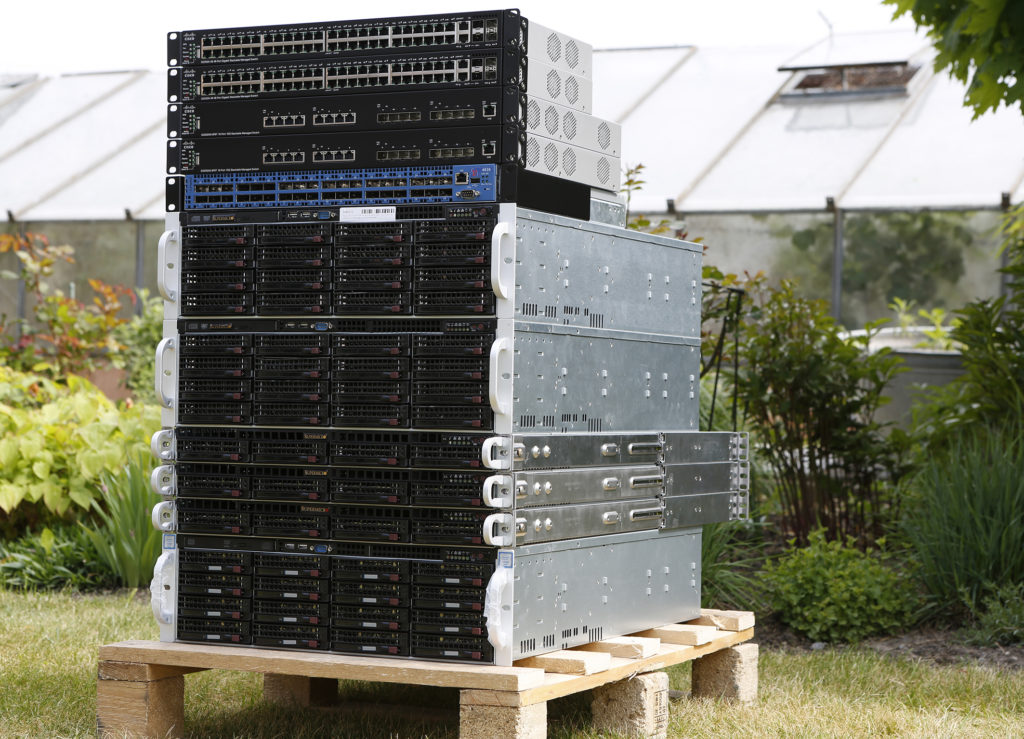
Alle Server (Storage und Cluster-Knoten) sind mit je zwei Intel XEONs 3,2GHz und 256GB ECC RAM bestückt und laufen auf aktuellen Supermicro Boards. Für den Netzwerkstack haben alle Server neben IPMI und Dual 10GbE je eine Dual Infiniband und eine Intel X710 SFP+ Karte mit an Bord. Die Betriebssysteme laufen auf gespiegelten Intel DC SSDs. Auf dem Storage-Server ist dazu auf der Rückseite ein hotplugfähiges 2,5″ Dual Bay integriert.
Das Herzstück des I/O-Systems für Storage- & Backup-Systeme, speziell geflashte HCAs, Dual SFP+ Ethernet 10GbE, Dual Infiniband 40Gbit mit gespiegelten PCIe NAND Flash Modulen, garantiert ordentlichen Durchsatz bei minimaler Latenz:
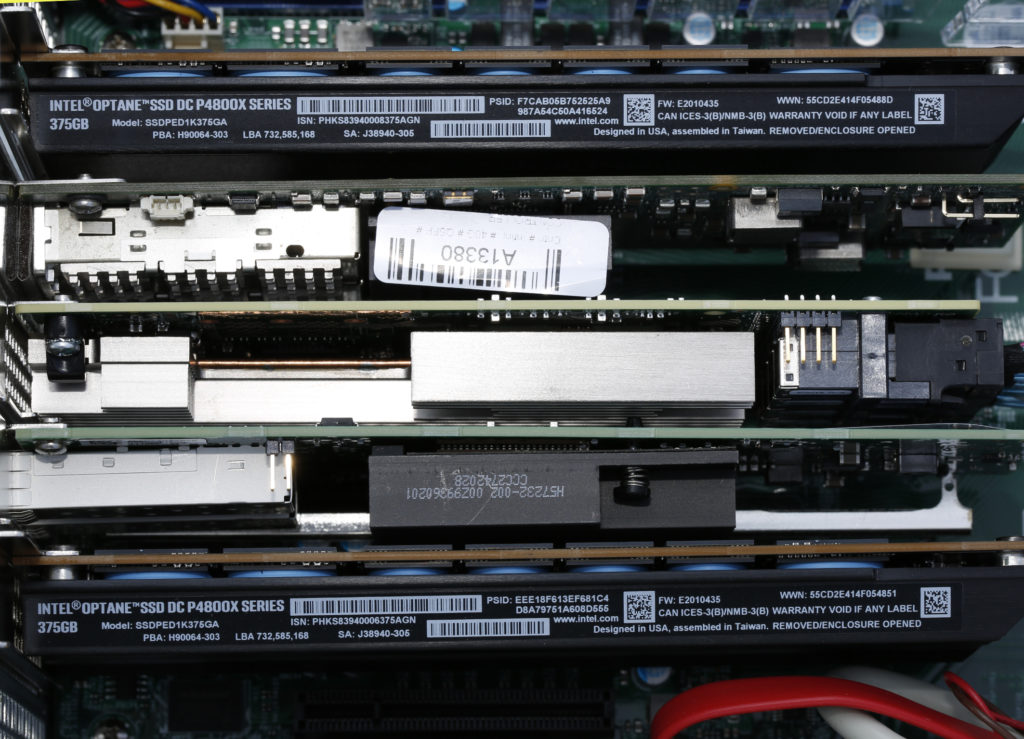
Die Frage nach dem Filesystem hat sich schnell beantwortet: ZFS soll es sein.
Die Vorteile sind:
- schnelle Rebuildzeit (resilver), da nur die belegten Blöcke übertragen werden
- schnelle Pool-Initialisierung, auch 140TB sind in wenigen Minuten initialisiert
- die Datenintegrität ist bei ZFS immer garantiert, d.h. ein Block wird so ausgeliefert, wie er gespeichert wurde
- einfache Poolerweiterung durch größere Ersatz-Platten
- einfacher Pool-Import inklusive ACLs, Snaphots, etc., der Platten auf neuer Hardware, wenn ZFS Version gleich oder größer ist auf dem Zielsystem bei unrelevanter Plattenfolge
Aktuelle ZFS basierte Systeme, die geeignet sind, sind FreeNAS 11.2 oder OmniOSce in Verbindung mit Napp-IT.
OmniOSce/Napp-IT ist im Grunde ein Abkömmling von Solaris Version 10 => OpenSolaris => illumos / OpenIndiana und damit ein direkter Nachfahre vom Unix System V. Da es unter FreeNAS/FreeBSD einige Überraschungen in Verbindung mit HA, Infiniband und iSCSI gab, werden wir uns bei Gelegenheit OmniOSce und Napp-IT in einer eigenen Analyse näher ansehen. Die PoC-Hardware dazu steht schon bereit. Mehr dazu in einem der nächsten Blogs.
Da FreeNAS nun über OpenZFS und auch über Mellanox Infiniband Treiber verfügt, gehen wir es an.
FreeNAS Setup
Die Installation wird als erledigt vorausgesetzt. Wir haben lediglich die beiden Intel Datacenter SSDs als Spiegel für die Installation ausgewählt. Wichtig ist, dass im BIOS auf UEFI umgestellt ist vor der Installation. Anschließend ist der Hostname zu vergeben, die beiden SFP+ Ports zu lagg0 (LACP), die beiden internen 10GbE Ports zu lagg1 (LACP) zusammen zu schalten. Mehr ist hier erst einmal nicht zu tun. Auf Cisco-Seite müssen innerhalb des Stacks auf den Core und den Management Switchen ebenfalls die entsprechend verwendeten Ports unter Link Aggregation zu einem lagg zusammen geschaltet werden. Für die Stack-Implementierung ist je Switch die Cisco Tesla Hybrid Firmware in der aktuellen Version zu flashen, wenn sich verschiedene Typen im Stack befinden sollen.
ZFS
Ein Blick auf das OpenZFS, welches FreeNAS mitbringt, verrät uns, dass es nah dran ist am aktuellen Oracle ZFS, die fehlende Verschlüsselung fällt auf, womit wir aber erst mal leben können:
root@freenas1[~]# zpool upgrade -v
This system supports ZFS pool feature flags.
The following features are supported:
FEAT DESCRIPTION
-------------------------------------------------------------
async_destroy (read-only compatible)
Destroy filesystems asynchronously.
empty_bpobj (read-only compatible)
Snapshots use less space.
lz4_compress
LZ4 compression algorithm support.
multi_vdev_crash_dump
Crash dumps to multiple vdev pools.
spacemap_histogram (read-only compatible)
Spacemaps maintain space histograms.
enabled_txg (read-only compatible)
Record txg at which a feature is enabled
hole_birth
Retain hole birth txg for more precise zfs send
extensible_dataset
Enhanced dataset functionality, used by other features.
embedded_data
Blocks which compress very well use even less space.
bookmarks (read-only compatible)
"zfs bookmark" command
filesystem_limits (read-only compatible)
Filesystem and snapshot limits.
large_blocks
Support for blocks larger than 128KB.
sha512
SHA-512/256 hash algorithm.
skein
Skein hash algorithm.
device_removal
Top-level vdevs can be removed, reducing logical pool size.
obsolete_counts (read-only compatible)
Reduce memory used by removed devices when their blocks are freed or remapped.
zpool_checkpoint (read-only compatible)
Pool state can be checkpointed, allowing rewind later.
The following legacy versions are also supported:
VER DESCRIPTION
--- --------------------------------------------------------
1 Initial ZFS version
2 Ditto blocks (replicated metadata)
3 Hot spares and double parity RAID-Z
4 zpool history
5 Compression using the gzip algorithm
6 bootfs pool property
7 Separate intent log devices
8 Delegated administration
9 refquota and refreservation properties
10 Cache devices
11 Improved scrub performance
12 Snapshot properties
13 snapused property
14 passthrough-x aclinherit
15 user/group space accounting
16 stmf property support
17 Triple-parity RAID-Z
18 Snapshot user holds
19 Log device removal
20 Compression using zle (zero-length encoding)
21 Deduplication
22 Received properties
23 Slim ZIL
24 System attributes
25 Improved scrub stats
26 Improved snapshot deletion performance
27 Improved snapshot creation performance
28 Multiple vdev replacements
For more information on a particular version, including supported releases,
see the ZFS Administration Guide.
root@freenas1[~]
Infiniband
Testweise manuelles Laden der Module für Infiniband unter FreeNAS/FreeBSD:
root@freenas1[~]# kldload mlx4
kldload: can't load mlx4: module already loaded or in kernel
root@freenas1[~]# kldload mlx4ib
root@freenas1[~]# kldload ipoib
root@freenas1[~]
Das aktiviert schon einmal die Karten, die uns mit Aufleuchten der orangen und grünen LEDs signalisieren, dass die Treiber geladen und die Karten einsatzbereit sind.
Das permanente Laden erfolgt in FreeBSD über die /boot/loader.conf.local.
Anders als unter FreeBSD wird allerdings die local Datei bei Updates oder Änderungen in den Tuneables (loader) gnadenlos überschrieben. FreeNAS ist eine Appliance und somit muss man Änderungen immer über die GUI vornehmen. Das gilt für alle Appliances, nebenbei auch für pfSense. Die loader Config darf deshalb nicht manuell editiert werden, da sie vom System früher oder später überschrieben werden wird.
Die korrekte Vorgehensweise ist über die GUI => System => Tunables => Add zu gehen und die entsprechenden Werte für die beiden loader einzutragen.
Nach dem Speichern finden wir unsere loader an gewohnter Stelle wieder:
root@freenas1[~]# cat /boot/loader.conf.local
mlx4ib_load="YES" # Be sure that Kernel modul Melloanox 4 Infiniband will be loaded
ipoib_load="YES" # Be sure that Kernel modul IP over Infiniband will be loaded
kernel="kernel"
module_path="/boot/kernel;/boot/modules;/usr/local/modules"
kern.cam.ctl.ha_id=0
root@freenas1[~]
Unter FreeBSD/FreeNAS kann für IP über Infiniband keine der bekannten Loadbalancer Methoden, wie Round Robin oder LACP verwendet werden. Da wir aber iSCSI für die Virtualisierungshosts, bzw. für das Proxmox-Cluster und den VMs einsetzen möchten, ist zwingend für die Erhöhung des Durchsatzes und für die Ausfallsicherheit zu sorgen.
Damit sind wir auch gleich schon beim Thema Multipath angelangt:
Multipath
Etwas Theorie dazu, wenn es lieber mehr sein darf:
Für Multipath ist je Netzwerk Gerät eine IP aus einem eigenen Subnet zu verwenden. Da wir die Infiniband-Netze weder routen, noch für andere Zwecke, außer latenzarm iSCSI zur Verfügung stellen wollen, verwenden wir neue Subnetze, außerhalb der bisher verwendeten.
In unserem Fall 10.20.24.0/24 für ib0 und 10.20.25.0/24 für ib1. Falls zwei HCAs mit je zwei Ports eingesetzt werden, werden analog vier eigene Subnetze benötigt.
Bei FreeBSD ist der Infiniband Treiber standardmäßig auf connected mode (CM) aktiv, was bedeutet, dass TCP/IP zum Einsatz kommt. Dafür ist normalerweise die MTU auf 65520 einzustellen auf Server- und Client-Seite (Proxmox), um den maximalen Durchsatz zu ermöglichen.
Mit diesen Werten hatten wir allerdings Probleme auf der Client-Seite mit SCSI-Kernel-Fehler-Meldungen. Durch heran tasten haben wir eine MTU von 40950 als zuverlässig ermittelt. Die Ursache ist aktuell nicht ganz klar. Wir vermuten Buffer-Probleme innerhalb der Treiber-Implementierung. Das könnte der Grund sein, weshalb Mellanox die ConnectX-2 Karten nicht für FreeBSD frei gegeben hatte. Wir wollen im Zuge des OmniOSce PoC-Projektes vorher auch noch ConnectX-3 Karten unter FreeBSD testen. Möglicherweise erledigt sich das damit auch schon. Mehr dazu, wenn wir die spezifischen Tests abgeschlossen haben. Aktuell genügt uns das Setup, wie es ist, da wir insgesamt mit vier virtuellen Testmaschinen beim Performance-Test auf einen Gesamtdurchsatz von über. 3.000 MB/s kommen, was dem ermittelten maximalen Wert von 3.134 MB/s der gespiegelten Intel Optane SSDs bereits sehr nahe kommt. Faktisch geht nicht mehr viel raus zu holen.
Das Setup der Infiniband-Karte ib0 sieht damit folgendermaßen aus:
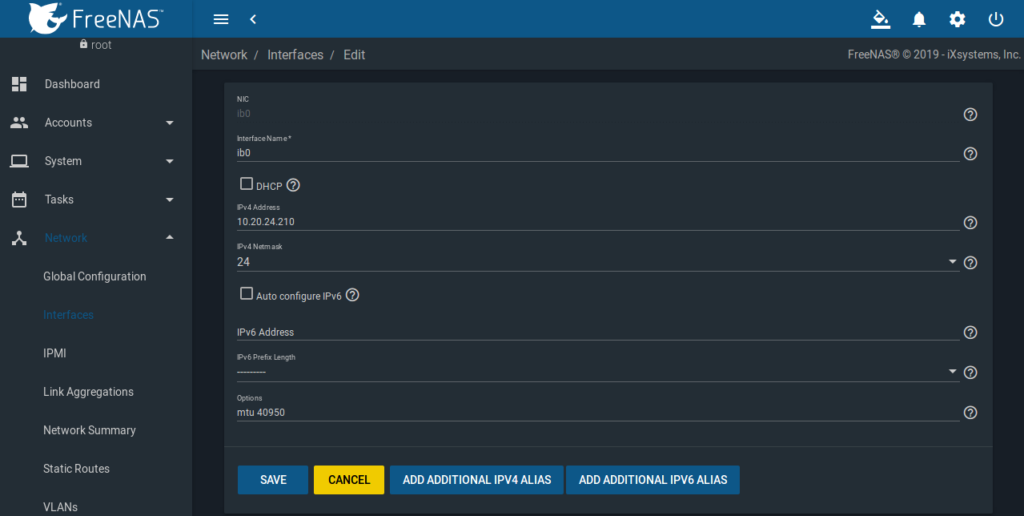
Analog dazu ist ib1 einzurichten.
Pool Setup
Für Performance ist ein RAID-Z Pool ungeeignet. Zum einen wird bei einem Rebuild dann von allen Platten gelesen, was die Performance extrem nach unten zieht, zum anderen zum anderen sind die Schreib-/Lesewerte damit nicht befriedigent.
Es ist daher dringend empfohlen, VDEVs aus je zwei gespiegelten Platten (Mirroring) zu einem Pool zusammen zu schalten. In unserem Setup sind das 16 HGST 10TB HE2 SAS3 Platten, also 8 VDEVs mit je zwei Platten im Spiegelverbund plus die zwei Intel Optanes zu einem Spiegel verbundenen VDEV als SLOG.
Der Pool hat als Sync-Methode „Standard“, „lz4“ als Kompression, der Share Type ist „Unix“, Atime ist „off“, Deduplication ist „off“, der Rest bleibt Default:
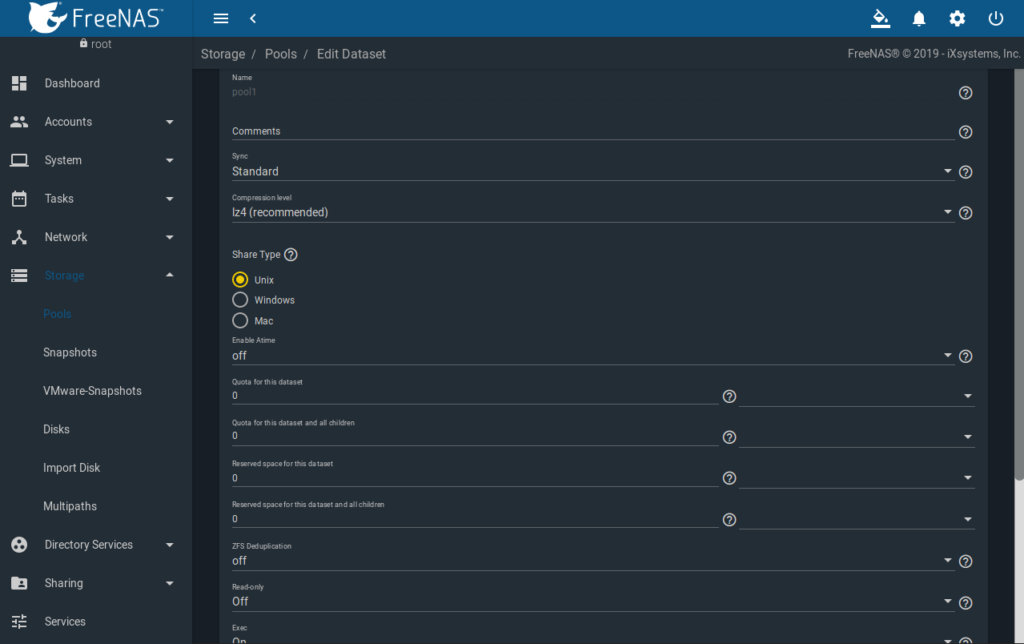
Im Pool werden dann drei Datasets benötigt, wobei die ersten beiden via NFS frei gegeben werden:
- Proxmox-ISO-Images
- Proxmox-Snapshots
- iSCSI
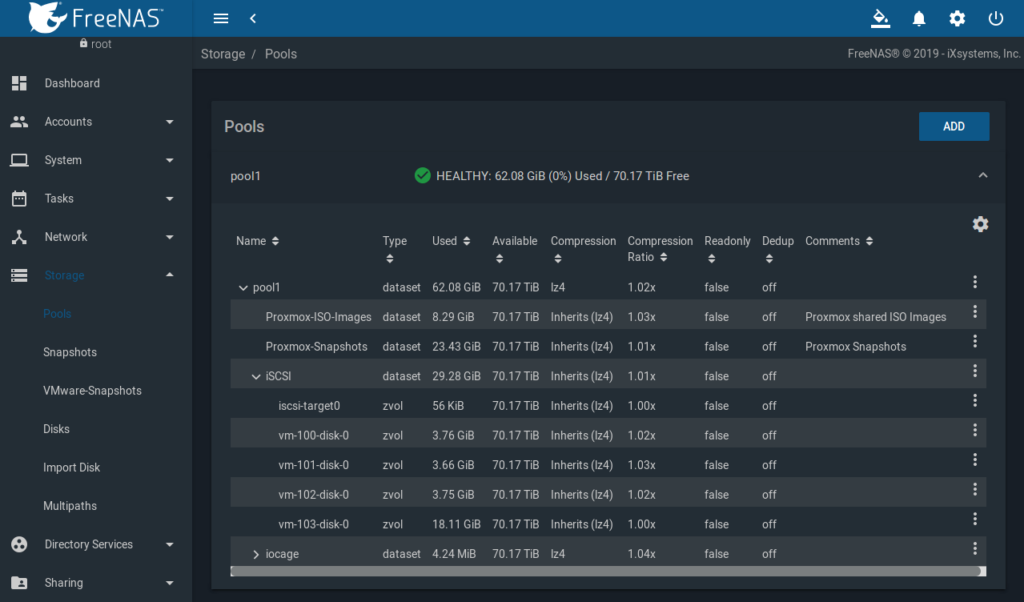
NFS Sharing
FreeNAS GUI => Sharing => Unix (NFS) Shares
Je Dataset Proxmox-* ist ein Share anzulegen mit aktiviertem All Dirs und mit den IPs der Proxmox-Cluster-Knoten aus dem SFP+ lagg0 Subnetz:

iSCSI Multipath Setup
Target Global Configuration
FreeNAS GUI => Sharing => Block (iSCSI) => Target Global Configuration:
Basename = iqn.2019-05.de.getcom.freenas1
Pool Availble Space Threshold (%) = 75
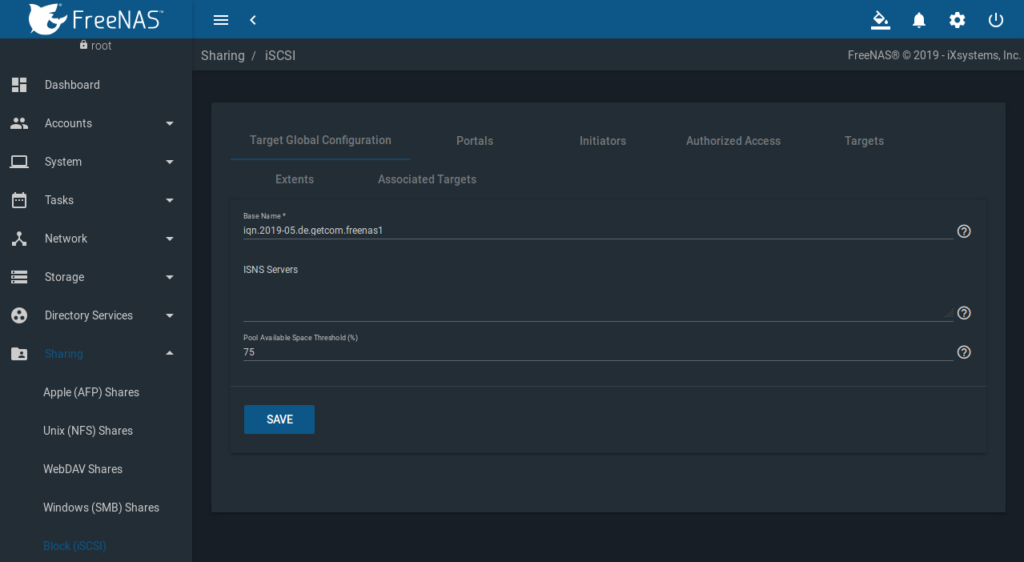
Portals
FreeNAS GUI => Sharing => Block (iSCSI) => Portals
Je Infiniband Subnet, bzw. IP, ist ein Portal zu erstellen.
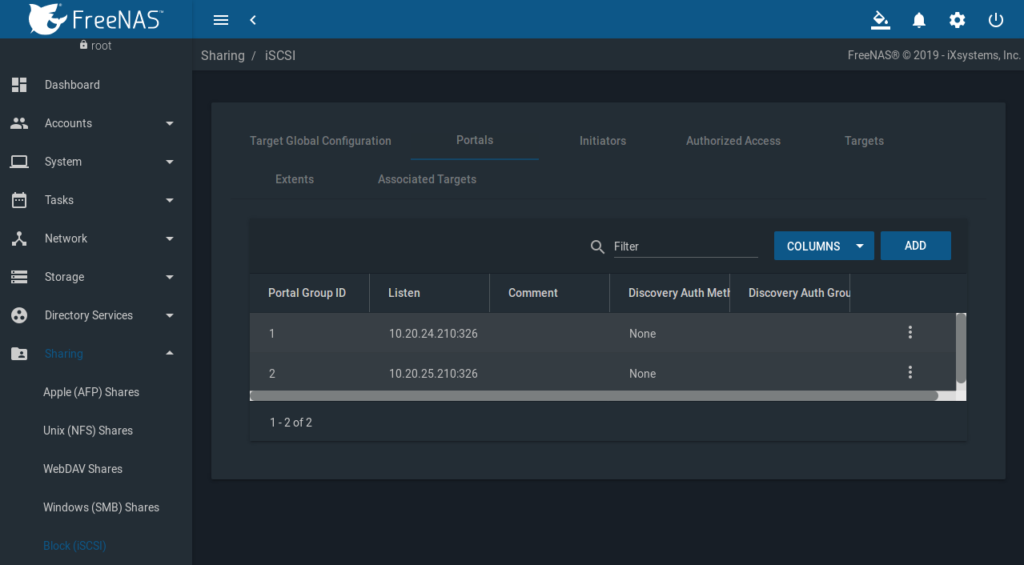
Initiators
FreeNAS GUI => Sharing => Block (iSCSI) => Initiators
Es wird ein Initator benötigt, zuerst einmal ohne Einschränkung (ALL/ALL):
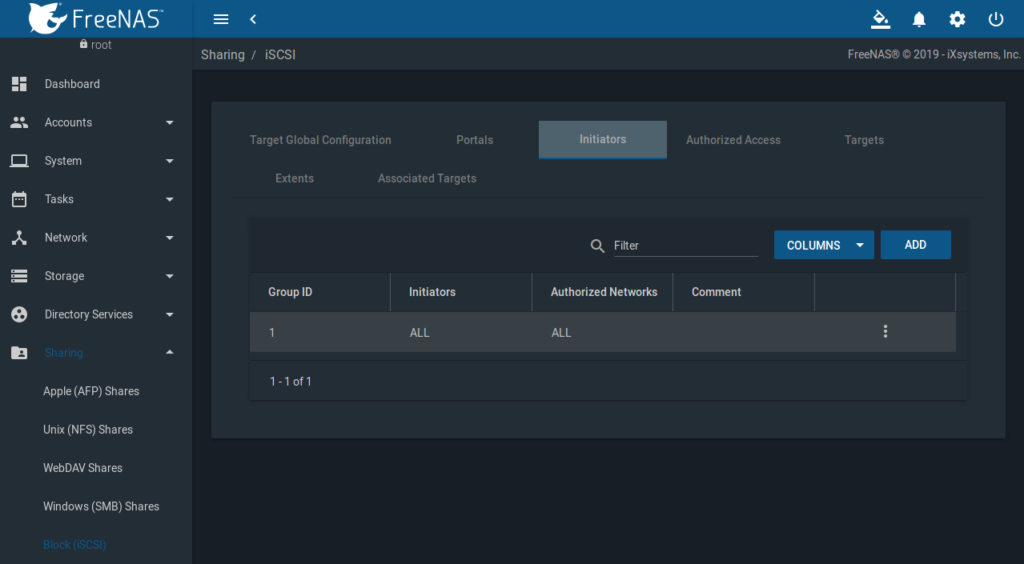
Authorized Access
FreeNAS GUI => Sharing => Block (iSCSI) => Authorized Access.
Keine Einschränkungen, das kann später geändert werden, wird aber nicht wirklich benötigt, da iSCSI nur auf den von Außen nicht erreichbaren Infiniband Subnetzen aktiv ist.
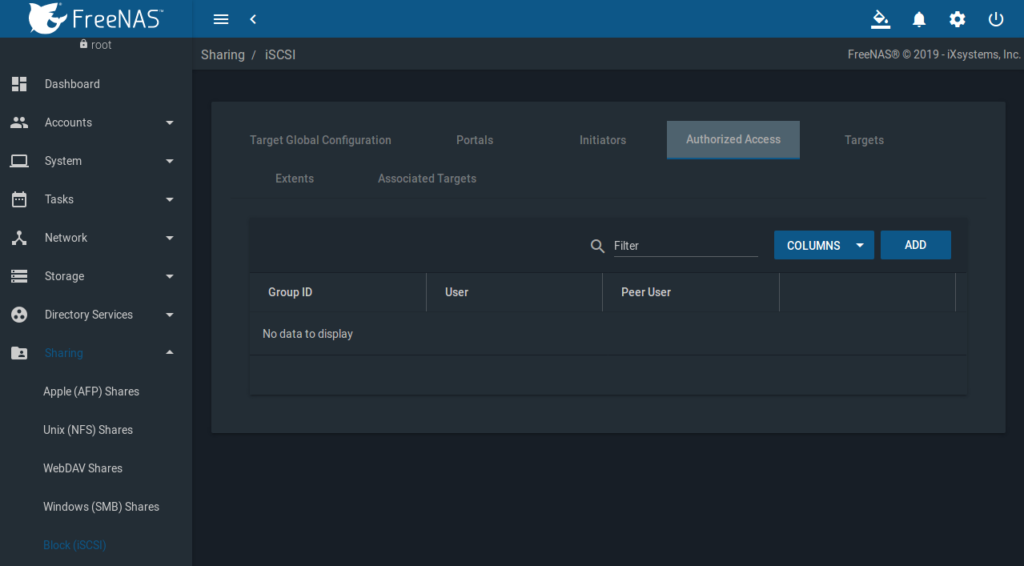
Targets
FreeNAS GUI => Sharing => Block (iSCSI) => Targets
Hier ist jetzt ein Target anzulegen. Der Name wird klein geschrieben und ist hier frei wählbar, kann also proxmox, proxmox0, iscsi oder wie in unserem Fall iscsi-target0 heißen. Dem Target sind beide Portal Group IDs „1“ + „2“ und die Initiator Group ID „1“ zuzuweisen:
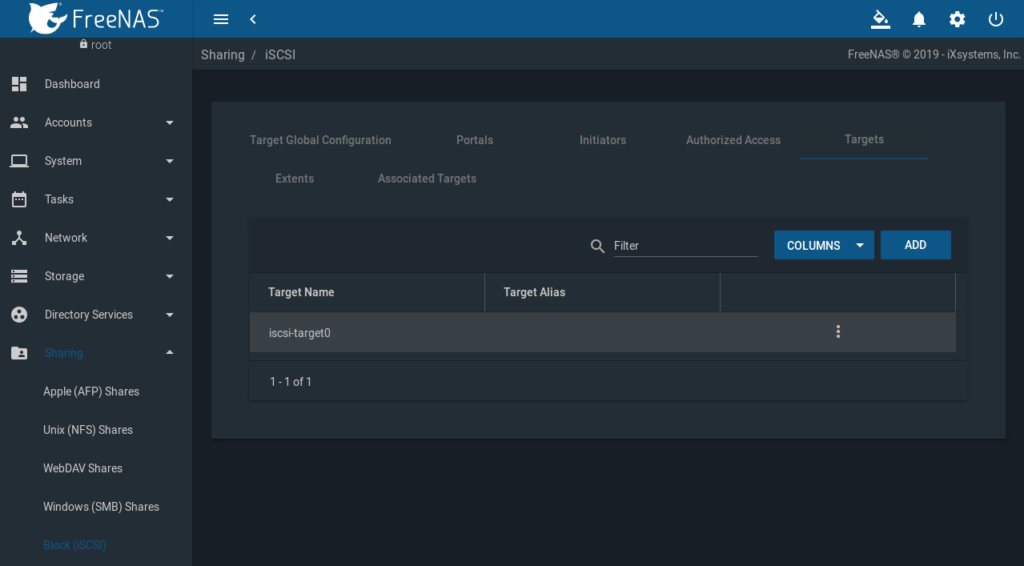
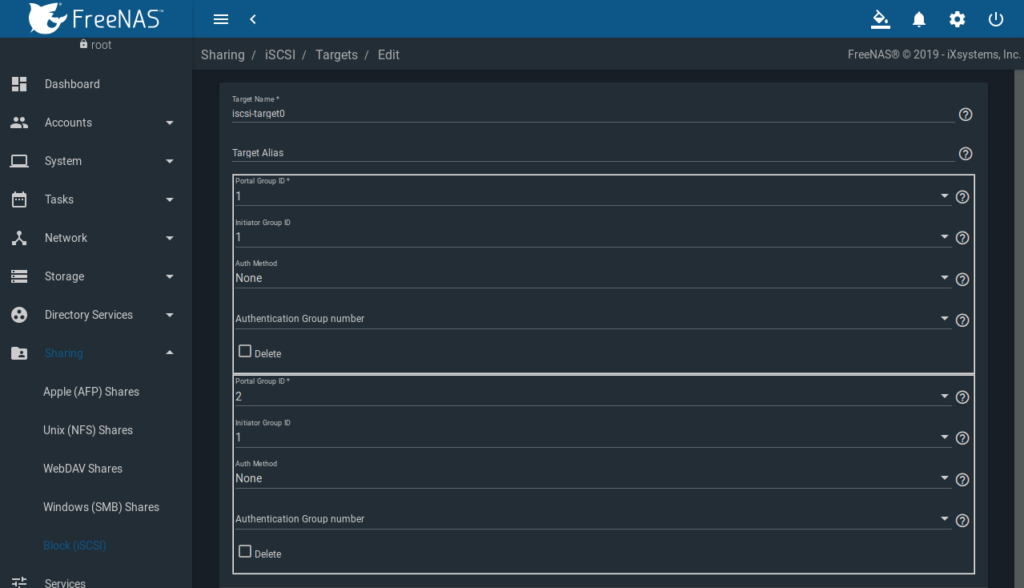
Extents
FreeNAS GUI => Sharing => Block (iSCSI) => Extents
Wie im Screenshot ersichtlich, entsprechend die Werte auswählen:
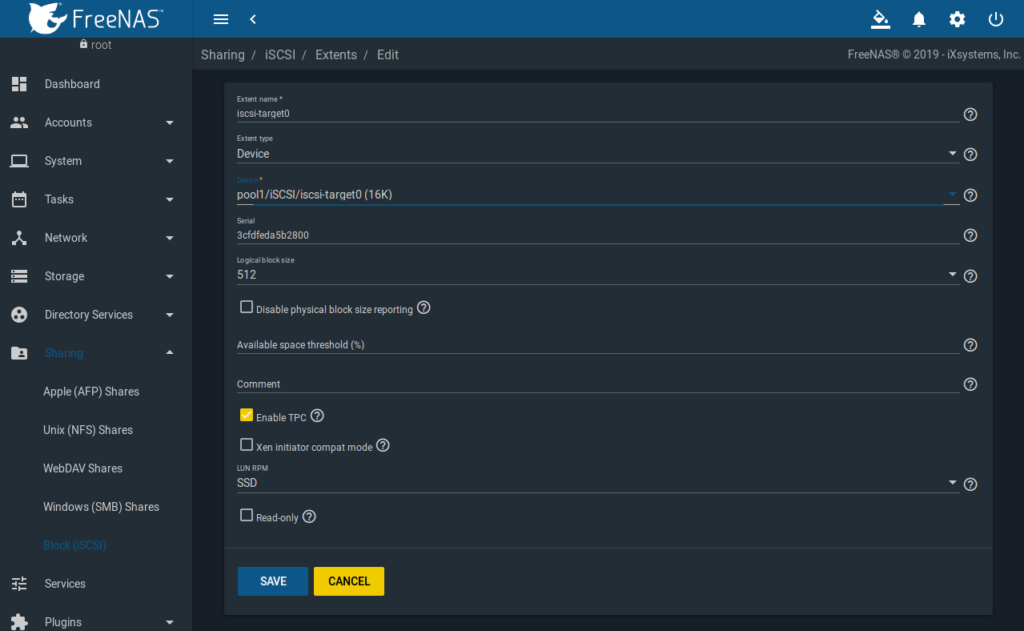
Associated Targets
FreeNAS GUI => Sharing => Block (iSCSI) => Associated Targets
Wie im Screenshot ersichtlich, entsprechend auswählen:
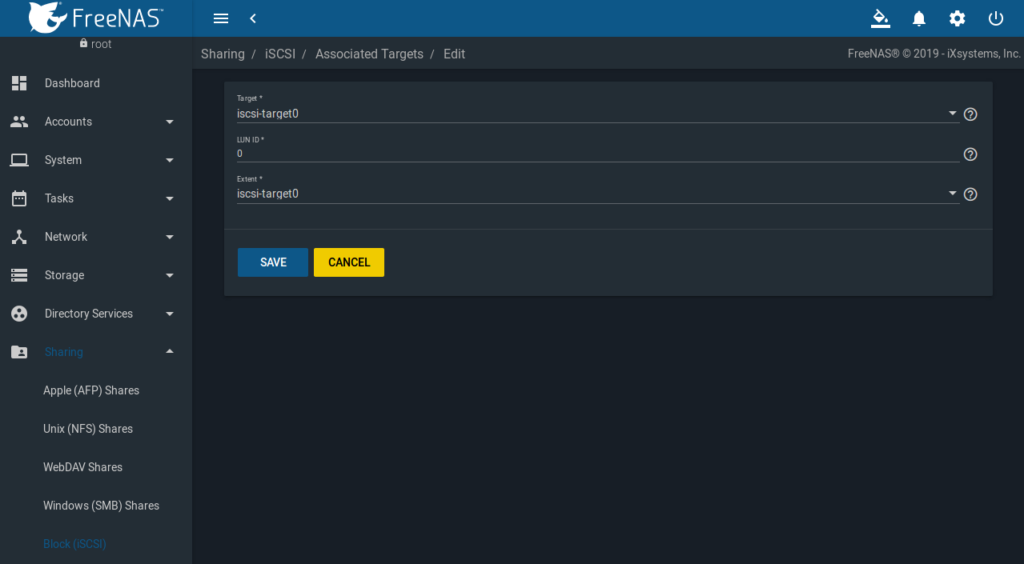
Damit ist das iSCSI Setup abgeschlossen.
Aktivierung des iSCSI und NFS Services
FreeNAS GUI => Services => iSCSI
FreeNAS GUI => Services => NFS
Start Automatically muss ausgewählt werden und den Schalter dann nach rechts ziehen:
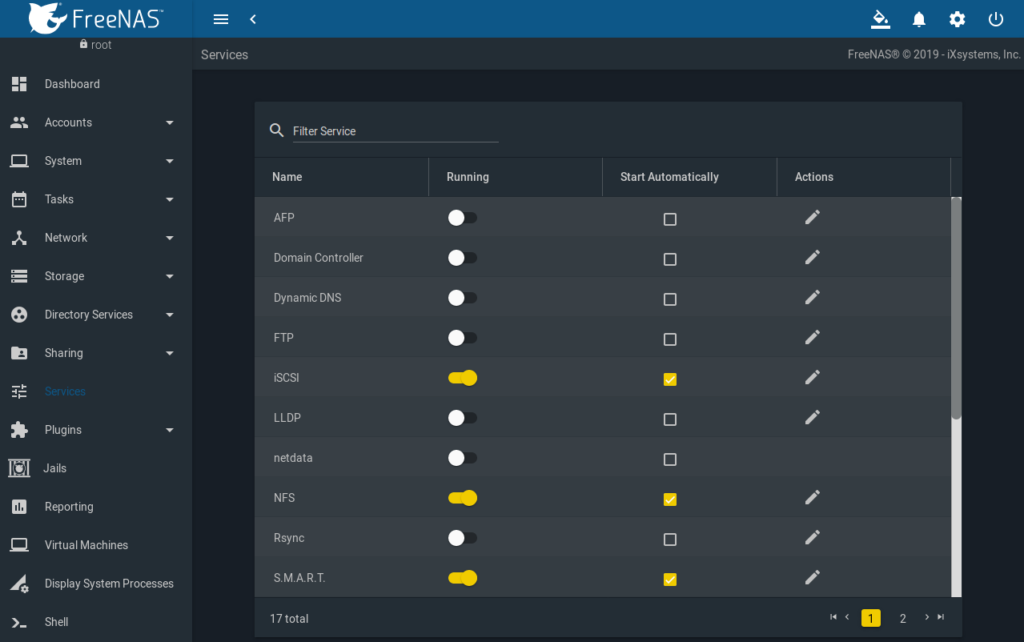
Damit ist das Setup auf der FreeNAS Seite abgeschlossen.
Proxmox Setup
von Ralf Schweiger | Dez. 31, 2018 | Bareos-Server, Free BSD, Free NAS
Verwendete Komponenten:



Voraussetzung für dieses Setup:
- FreeNAS 11.2-RELEASE-p6
- Vollständige Basiskonfiguration inklusive Netzwerkdevices, Storage-Pool, etc.
Um Bareos Server und die WebUI auf einem FreeNAS 11.2 Storage Server zu installieren, muss man sich über folgendes im Klaren sein:
- FreeNAS ist eine Appliance und somit ist per Design keine direkte Installation einer zusätzlichen Software vorgesehen und das muss auch so bleiben.
- FreeNAS bietet ein Plugin für Bacula, nicht jedoch für Bareos.
- Alle zusätzlichen Services, die nicht unter FreeNAS verfügbar sind, müssen daher in jeweils einem eigenen Jail laufen.
Vorgehensweise:
Wir erstellen ein Jail mit dem Namen „bareos-server“ innerhalb von FreeNAS, weisen ein Ethernet-Device zu und starten das Jail:
- Jail Name: bareos-server
- Template: FreeBSD
- IPv4 address: <static_ip>
- Autostart: Checked
- VIMAGE: Checked
- Alle anderen Optionen bleiben default (oder basierend auf einer eigenen Konfiguration)
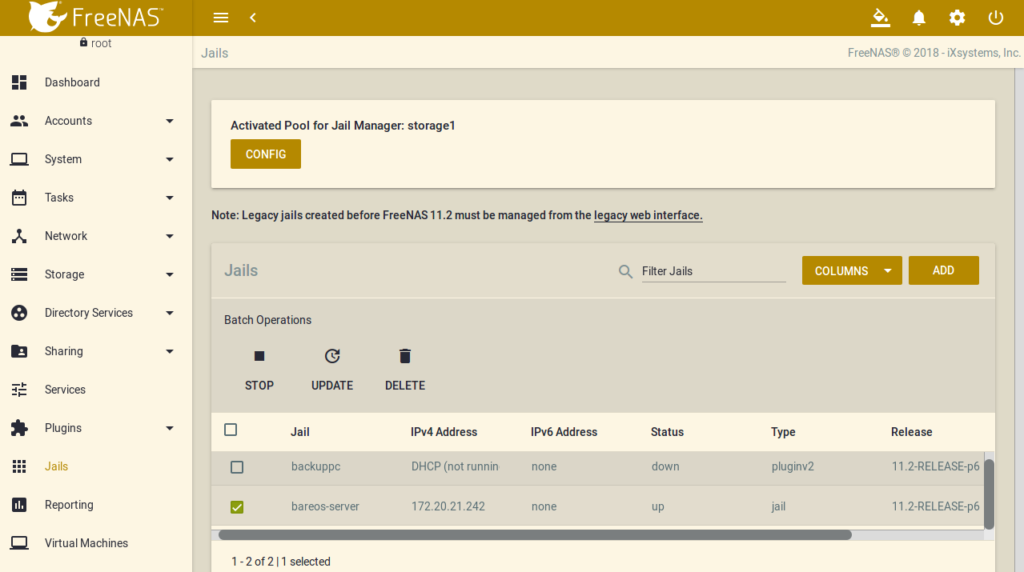
Um Zugriff von Außen via SSH auf den neuen „bareos-server“ zu erhalten, sind folgende Schritte nötig:
Rechts am Ende des Jail-Eintrags befinden sich drei Punkte. Beim Klick darauf öffnet sich ein Kontextmenü. Hier eine Shell öffnen. (Jails > Jails > bareos-server > Shell)
Innerhalb der Shell des „bareos-server“ Jails folgende Änderungen vornehmen:
Änderung /etc/rc.conf:
echo 'sshd_enable="YES"' >>/etc/rc.conf
- Erlaube root login. (alternativ kann man einen Benutzer anlegen und sudo verwenden)
- Start SSH service.
- Ändere das root Passwort.
passwd- Folge dem Prompt, um das Passwort zu ändern.
Von nun an kann man sich direkt via SSH am bareos-server anmelden mit
Anschließend sind folgende Vorbereitungen notwendig:
sed -i '' s/quarterly/latest/g /etc/pkg/FreeBSD.confpkg search bareospkg install bareos-client bareos-server bareos-webui postgresql95-server nginx php72 php72-xml php72-session php72-simplexml php72-gd php72-ctype php72-mbstring php72-zlib php72-tokenizer php72-iconv php72-pecl-mcrypt php72-pear-DB_ldap php72-zip php72-dom php72-sqlite3 php72-gettext php72-curl php72-json php72-opcache php72-wddx php72-hash php72-soapecho 'bareos_sd_enable="YES"' >>/etc/rc.conf
Mit der zweiten Zeile wird der bareos_sd service beim Booten des Jails mit gestartet.
Nun ist noch eine Konfiguration notwendig, die alle bareos-sd.d/* Konfigurationen lädt:
echo '@/usr/local/etc/bareos/bareos-sd.d/*/*' >>/usr/local/etc/bareos/bareos-sd.conf
Nun benötigen wir einen pgsql login und setzen die Collation auf deutsch, da wir bei der Suche deutsche Umlaute erwarten:
cat >> /etc/login.conf << __EOF
# PostgreSQL
pgsql:\
:lang=de_DE.UTF-8:\
:setenv=LC_COLLATE=C:\
:tc=default:
__EOF
Neuladen der Login-Datenbank:
Nun initialisieren wir die Datenbanken:
/usr/local/etc/rc.d/postgresql initdb
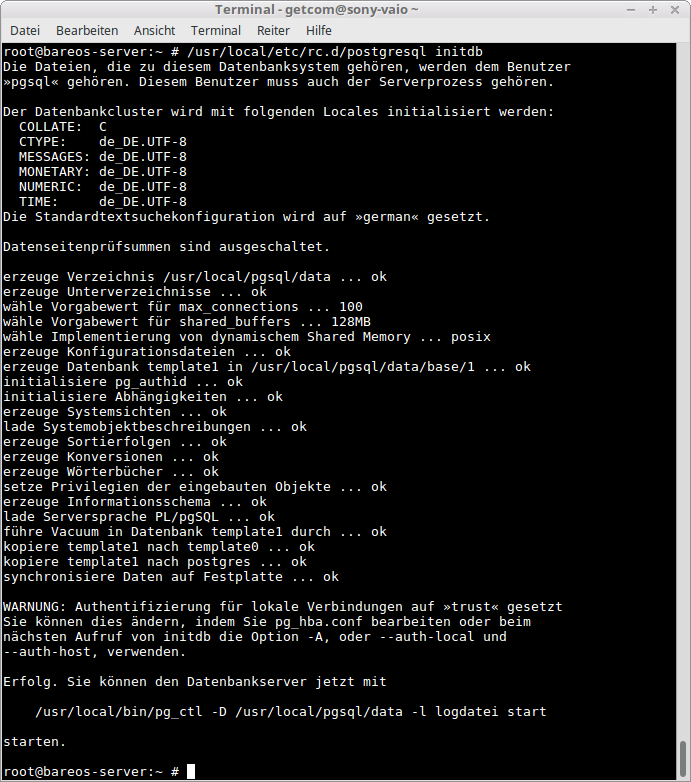
Nun starten wir den PostgreSQL:
root@bareos-server:~ # /usr/local/etc/rc.d/postgresql start
LOG: Logausgabe nach stderr endet
TIPP: Die weitere Logausgabe geht an Logziel "syslog".
Wir kümmern uns nun um die Bareos Server Konfiguration. Die nicht benötigten*.sample Files werden gelöscht und die Permissions korrigiert:
chown -R bareos:bareos /usr/local/etc/bareosfind /usr/local/etc/bareos -type f -exec chmod 640 {} ';'find /usr/local/etc/bareos -type d -exec chmod 750 {} ';'find /usr/local/etc/bareos -name \*\.sample -delete
Für das „Tracking“ behalten wir eine Kopie der originalen Konfiguration:
cp -a /usr/local/etc/bareos /usr/local/etc/bareos.orig
Nun passen wie die Bareos Catalog Konfiguration an unter:
/usr/local/etc/bareos.ORG/bareos-dir.d/catalog/MyCatalog.conf
Nach der Anpassung sieht das so aus (das Passwort ist natürlich entsprechend anzupassen):
Catalog {
Name = MyCatalog
dbdriver = "postgresql"
dbname = "bareos"
dbuser = "bareos"
dbpassword = "BAREOS-DATABASE-PASSWORD"
}
Wir prüfen, ob beide Benutzer in der bareos-Gruppe sind:
root@bareos-server:~ # pw groupmod bareos -m pgsql
root@bareos-server:~ # id pgsql
uid=70(pgsql) gid=70(pgsql) groups=70(pgsql),997(bareos)
root@bareos-server:~ # pw groupmod bareos -m www
root@bareos-server:~ # id www
uid=80(www) gid=80(www) groups=80(www),997(bareos)
Nun wird die PostgreSQL Datenbank für die Bareos Instanz vorbereitet. Dazu verwenden wir die Skripte aus dem Bareos Paket unter /usr/local/lib/bareos/scripts.
root@bareos-server:~ # su - pgsql
$ whoami
pgsql
$ /usr/local/lib/bareos/scripts/create_bareos_database
Creating postgresql database
CREATE DATABASE
ALTER DATABASE
Database encoding OK
Creating of bareos database succeeded.
$ /usr/local/lib/bareos/scripts/make_bareos_tables
Making postgresql tables
CREATE TABLE
ALTER TABLE
CREATE INDEX
CREATE TABLE
CREATE INDEX
CREATE INDEX
CREATE TABLE
CREATE INDEX
CREATE TABLE
CREATE INDEX
CREATE TABLE
CREATE INDEX
CREATE TABLE
CREATE TABLE
CREATE INDEX
CREATE TABLE
CREATE INDEX
CREATE TABLE
CREATE INDEX
CREATE INDEX
CREATE TABLE
CREATE TABLE
CREATE TABLE
CREATE TABLE
CREATE INDEX
CREATE TABLE
CREATE INDEX
CREATE TABLE
CREATE INDEX
CREATE TABLE
CREATE TABLE
CREATE TABLE
CREATE INDEX
CREATE TABLE
CREATE INDEX
CREATE TABLE
CREATE INDEX
CREATE TABLE
CREATE TABLE
CREATE TABLE
CREATE TABLE
CREATE TABLE
CREATE TABLE
CREATE TABLE
CREATE TABLE
INSERT 0 1
INSERT 0 1
INSERT 0 1
INSERT 0 1
INSERT 0 1
INSERT 0 1
INSERT 0 1
INSERT 0 1
INSERT 0 1
INSERT 0 1
INSERT 0 1
INSERT 0 1
INSERT 0 1
INSERT 0 1
INSERT 0 1
INSERT 0 1
INSERT 0 1
INSERT 0 1
INSERT 0 1
INSERT 0 1
INSERT 0 1
INSERT 0 1
INSERT 0 1
INSERT 0 1
INSERT 0 1
INSERT 0 1
DELETE 0
INSERT 0 1
Creation of Bareos PostgreSQL tables succeeded.
$ /usr/local/lib/bareos/scripts/grant_bareos_privileges
Granting postgresql tables
CREATE ROLE
GRANT
GRANT
GRANT
GRANT
GRANT
GRANT
GRANT
GRANT
GRANT
GRANT
GRANT
GRANT
GRANT
GRANT
GRANT
GRANT
GRANT
GRANT
GRANT
GRANT
GRANT
GRANT
GRANT
GRANT
GRANT
GRANT
GRANT
GRANT
GRANT
GRANT
GRANT
GRANT
GRANT
GRANT
GRANT
GRANT
GRANT
GRANT
GRANT
GRANT
GRANT
GRANT
GRANT
GRANT
Privileges for user bareos granted ON database bareos.
$
Verfizierung, ob die benötigte DB vorhanden ist:
su -m bareos -c 'psql -l'
List of databases
Name | Owner | Encoding | Collate | Ctype |Access privileges
-----------+-------+-----------+---------+-------------+-----------------
bareos | pgsql | SQL_ASCII | C | C |
postgres | pgsql | UTF8 | C | de_DE.UTF-8 |
template0 | pgsql | UTF8 | C | de_DE.UTF-8 | =c/pgsql +
| | | | | pgsql=CTc/pgsql
template1 | pgsql | UTF8 | C | de_DE.UTF-8 | =c/pgsql +
| | | | | pgsql=CTc/pgsql
(4 rows)
Wir fügen die PostgreSQL Database Jobs ein in crontab(1):
root@bareos-server:~ # su - pgsql
$ whoami
pgsql
$ cat >/usr/local/pgsql/vacuum.sh << __EOF
#! /bin/sh
/usr/local/bin/vacuumdb -a -z 1> /dev/null 2> /dev/null
/usr/local/bin/reindexdb -a 1> /dev/null 2> /dev/null
/usr/local/bin/reindexdb -s 1> /dev/null 2> /dev/null
__EOF
$ chmod +x /usr/local/pgsql/vacuum.sh
$ cat /usr/local/pgsql/vacuum.sh
#! /bin/sh
/usr/local/bin/vacuumdb -a -z 1> /dev/null 2> /dev/null
/usr/local/bin/reindexdb -a 1> /dev/null 2> /dev/null
/usr/local/bin/reindexdb -s 1> /dev/null 2> /dev/null
$ crontab -e
crontab: no crontab for pgsql - using an empty one
# DO NOT EDIT THIS FILE - edit the master and reinstall.
# (/tmp/crontab.Be9j9VVCUa installed on Thu Apr 26 21:45:04 2018)
# (Cron version -- $FreeBSD$)
0 0 * * * /usr/local/pgsql/vacuum.sh
/tmp/crontab.g8mCztyvSv: 5 lines, 191 characters.
crontab: installing new crontab
$ crontab -l
# DO NOT EDIT THIS FILE - edit the master and reinstall.
# (/tmp/crontab.Be9j9VVCUa installed on Thu Apr 26 21:45:04 2018)
# (Cron version -- $FreeBSD$)
0 0 * * * /usr/local/pgsql/vacuum.sh
$ exit
root@bareos-server:~ # cat /var/cron/tabs/pgsql
# DO NOT EDIT THIS FILE - edit the master and reinstall.
# (/tmp/crontab.g8mCztyvSv installed on Mon Dec 31 05:01:54 2018)
# (Cron version -- $FreeBSD: releng/11.2/usr.sbin/cron/crontab/crontab.c 321241 2017-07-19 20:22:16Z ngie $)
# DO NOT EDIT THIS FILE - edit the master and reinstall.
# (/tmp/crontab.Be9j9VVCUa installed on Thu Apr 26 21:45:04 2018)
# (Cron version -- $FreeBSD$)
0 0 * * * /usr/local/pgsql/vacuum.sh
root@bareos-server:~ # su -m pgsql -c 'crontab -l'
# DO NOT EDIT THIS FILE - edit the master and reinstall.
# (/tmp/crontab.Be9j9VVCUa installed on Thu Apr 26 21:45:04 2018)
# (Cron version -- $FreeBSD$)
0 0 * * * /usr/local/pgsql/vacuum.sh
Wir legen nun lokal die bareos-Verzeichnisse an, das /bareos-dr dient später als NFS mount point für ein weiteres DR-Storage:
root@bareos-server:~ # mkdir -p /bareos/bootstrap
root@bareos-server:~ # mkdir -p /bareos/restore
root@bareos-server:~ # mkdir -p /bareos/storage/FileStorage
root@bareos-server:~ # mkdir -p /bareos/storage/FileStorage2
root@bareos-server:~ # mkdir -p /bareos-dr/bootstrap
root@bareos-server:~ # mkdir -p /bareos-dr/restore
root@bareos-server:~ # mkdir -p /bareos-dr/storage/FileStorage
root@bareos-server:~ # mkdir -p /bareos-dr/storage/FileStorage2
root@bareos-server:~ # chown -R bareos:bareos /bareos /bareos-dr
root@bareos-server:~ # find /bareos /bareos-dr -ls | column -t
120761 1 drwxr-xr-x 5 bareos bareos 5 Dec 31 05:20 /bareos
120774 1 drwxr-xr-x 3 bareos bareos 3 Dec 31 05:20 /bareos/storage
120775 1 drwxr-xr-x 2 bareos bareos 2 Dec 31 05:20 /bareos/storage/FileStorage
120786 1 drwxr-xr-x 2 bareos bareos 2 Dec 31 05:20 /bareos/storage/FileStorage2
120768 1 drwxr-xr-x 2 bareos bareos 2 Dec 31 05:20 /bareos/restore
120762 1 drwxr-xr-x 2 bareos bareos 2 Dec 31 05:20 /bareos/bootstrap
120776 1 drwxr-xr-x 5 bareos bareos 5 Dec 31 05:21 /bareos-dr
120777 1 drwxr-xr-x 2 bareos bareos 2 Dec 31 05:20 /bareos-dr/bootstrap
120783 1 drwxr-xr-x 2 bareos bareos 2 Dec 31 05:20 /bareos-dr/restore
120784 1 drwxr-xr-x 3 bareos bareos 3 Dec 31 05:21 /bareos-dr/storage
120785 1 drwxr-xr-x 2 bareos bareos 2 Dec 31 05:21 /bareos-dr/storage/FileStorage
120787 1 drwxr-xr-x 2 bareos bareos 2 Dec 31 05:21 /bareos-dr/storage/FileStorage2
Bareos
Im nächsten Schritt benötigen wir die Passwörter für die Bareos Subsysteme, wie wir das bereits analog für dasBAREOS-DATABASE-PASSWORD für den bareos User für die PostgreSQL Bareos Datenbank erstellt hatten:
- BAREOS-DATABASE-PASSWORD
- BAREOS-DIR-PASSWORD
- BAREOS-SD-PASSWORD
- BAREOS-FD-PASSWORD
- BAREOS-MON-PASSWORD
- ADMIN-PASSWORD
Wir verwenden dabei /dev/urandom zur Generierung der jeweiligen Passwörter, wie hier im Beispiel (je länger, je sicherer):
root@bareos-server:~ # cat /dev/urandom | env LC_CTYPE=C tr -dc a-zA-Z0-9 | head -c 60 ; echo
R32CERWerLmlHunzCfiTOEjhG2oo4oaWmTChzlQiuOEh50sSSwb7xKccOw8g
Wir haben bereits die MyCatalog.conf mit nachfolgendem Inhalt angelegt:
# cat /usr/local/etc/bareos/bareos-dir.d/catalog/MyCatalog.conf
Catalog {
Name = MyCatalog
dbdriver = "postgresql"
dbname = "bareos"
dbuser = "bareos"
dbpassword = "BAREOS-DATABASE-PASSWORD"
}
Anlegen von /usr/local/etc/bareos/bconsole.d falls nicht vorhanden:
# test -d /usr/local/etc/bareos/bconsole.d/ || mkdir -p /usr/local/etc/bareos/bconsole.d/;\
chown bareos.bareos /usr/local/etc/bareos/bconsole.d
Symbolischen Link erstellen, falls notwendig:
# test -n /usr/local/etc/bareos/bconsole.d/bconsole.conf || \
ln -s /usr/local/etc/bareos/bconsole.conf /usr/local/etc/bareos/bconsole.d/
Inhalt von /usr/local/etc/bareos/bconsole.d/bconsole.conf nach der Anpassung:
# cat /usr/local/etc/bareos/bconsole.d/bconsole.conf
#
# Bareos User Agent (or Console) Configuration File
#
Director {
Name = bareos-server.getcom.de
address = localhost
Password = "BAREOS-DIR-PASSWORD"
Description = "Bareos Console credentials for local Director"
}
Inhalt von/usr/local/etc/bareos/bareos-dir.d/director/bareos-dir.conf nach der Anpassung:
# cat /usr/local/etc/bareos/bareos-dir.d/director/bareos-dir.conf
Director {
Name = bareos-server.getcom.de
QueryFile = "/usr/local/lib/bareos/scripts/query.sql"
Maximum Concurrent Jobs = 100
Password = "BAREOS-DIR-PASSWORD"
Messages = Daemon
Auditing = yes
# Enable the Heartbeat if you experience connection losses
# (eg. because of your router or firewall configuration).
# Additionally the Heartbeat can be enabled in bareos-sd and bareos-fd.
#
# Heartbeat Interval = 1 min
# remove comment in next line to load dynamic backends from specified directory
# Backend Directory = /usr/local/lib
# remove comment from "Plugin Directory" to load plugins from specified directory.
# if "Plugin Names" is defined, only the specified plugins will be loaded,
# otherwise all director plugins (*-dir.so) from the "Plugin Directory".
#
# Plugin Directory = /usr/local/lib/bareos/plugins
# Plugin Names = ""
}
Inhalt von /usr/local/etc/bareos/bareos-dir.d/job/RestoreFiles.confnach der Anpassung:
# cat /usr/local/etc/bareos/bareos-dir.d/job/RestoreFiles.conf
Job {
Name = "RestoreFiles"
Description = "Standard Restore."
Type = Restore
Client = Default
FileSet = "SelfTest"
Storage = File
Pool = BR-MO
Messages = Standard
Where = /bareos/restore
Accurate = yes
}
Neues File /usr/local/etc/bareos/bareos-dir.d/client/Default.conf :
# cat /usr/local/etc/bareos/bareos-dir.d/client/Default.conf
Client {
Name = Default
address = bareos-server.getcom.de
Password = "BAREOS-FD-PASSWORD"
}
Neues File /usr/local/etc/bareos/bareos-dir.d/client/bareos-server.getcom.de.conf :
# cat /usr/local/etc/bareos/bareos-dir.d/client/bareos-server.getcom.de.conf
Client {
Name = bareos-server.getcom.de
Description = "Client resource of the Director itself."
address = bareos-server.getcom.de
Password = "BAREOS-FD-PASSWORD"
}
Nachfolgendes File ist ohne Änderung:
# cat /usr/local/etc/bareos/bareos-dir.d/job/BackupCatalog.conf
Job {
Name = "BackupCatalog"
Description = "Backup the catalog database (after the nightly save)"
JobDefs = "DefaultJob"
Level = Full
FileSet="Catalog"
Schedule = "WeeklyCycleAfterBackup"
# This creates an ASCII copy of the catalog
# Arguments to make_catalog_backup.pl are:
# make_catalog_backup.pl
RunBeforeJob = "/usr/local/lib/bareos/scripts/make_catalog_backup.pl MyCatalog"
# This deletes the copy of the catalog
RunAfterJob = "/usr/local/lib/bareos/scripts/delete_catalog_backup"
# This sends the bootstrap via mail for disaster recovery.
# Should be sent to another system, please change recipient accordingly
Write Bootstrap = "|/usr/local/bin/bsmtp -h localhost -f \"\(Bareos\) \" -s \"Bootstrap for Job %j\" root@localhost" # (#01)
Priority = 11 # run after main backup
}
Nachfolgendes File ist ohne Änderung:
# cat /usr/local/etc/bareos/bareos-dir.d/messages/Standard.conf
Messages {
Name = Standard
Description = "Reasonable message delivery -- send most everything to email address and to the console."
operatorcommand = "/usr/local/bin/bsmtp -h localhost -f \"\(Bareos\) \\" -s \"Bareos: Intervention needed for %j\" %r"
mailcommand = "/usr/local/bin/bsmtp -h localhost -f \"\(Bareos\) \\" -s \"Bareos: %t %e of %c %l\" %r"
operator = root@localhost = mount # (#03)
mail = root@localhost = all, !skipped, !saved, !audit # (#02)
console = all, !skipped, !saved, !audit
append = "/var/log/bareos/bareos.log" = all, !skipped, !saved, !audit
catalog = all, !skipped, !saved, !audit
}
Nachfolgendes File ist ohne Änderung:
# cat /usr/local/etc/bareos/bareos-dir.d/messages/Daemon.conf
Messages {
Name = Daemon
Description = "Message delivery for daemon messages (no job)."
mailcommand = "/usr/local/bin/bsmtp -h localhost -f \"\(Bareos\) \\" -s \"Bareos daemon message\" %r"
mail = root@localhost = all, !skipped, !audit # (#02)
console = all, !skipped, !saved, !audit
append = "/var/log/bareos/bareos.log" = all, !skipped, !audit
append = "/var/log/bareos/bareos-audit.log" = audit
}
Pools
Per default hat Bareos vier Pools konfiguriert. Da wir sie nicht benutzen, löschen wir sie:
# ls -l /usr/local/etc/bareos/bareos-dir.d/pool
total 14
-rw-rw---- 1 bareos bareos 536 Apr 16 08:14 Differential.conf
-rw-rw---- 1 bareos bareos 512 Apr 16 08:14 Full.conf
-rw-rw---- 1 bareos bareos 534 Apr 16 08:14 Incremental.conf
-rw-rw---- 1 bareos bareos 48 Apr 16 08:14 Scratch.conf
# rm -f /usr/local/etc/bareos/bareos-dir.d/pool/*.conf
Wir legen nun zwei Pools für DAILY Backups und MONTHLY Backups an:
# cat /usr/local/etc/bareos/bareos-dir.d/pool/BRONZE-DAILY-POOL.conf
Pool {
Name = BR-DA
Pool Type = Backup
Recycle = yes # Bareos can automatically recycle Volumes
AutoPrune = yes # Prune expired volumes
Volume Retention = 7 days # How long should the Full Backups be kept? (#06)
Maximum Volume Bytes = 2G # Limit Volume size to something reasonable
Maximum Volumes = 100000 # Limit number of Volumes in Pool
Label Format = "BR-DA-" # Volumes will be labeled "BR-DA-"
}
# cat /usr/local/etc/bareos/bareos-dir.d/pool/BRONZE-MONTHLY-POOL.conf
Pool {
Name = BR-MO
Pool Type = Backup
Recycle = yes # Bareos can automatically recycle Volumes
AutoPrune = yes # Prune expired volumes
Volume Retention = 120 days # How long should the Full Backups be kept? (#06)
Maximum Volume Bytes = 2G # Limit Volume size to something reasonable
Maximum Volumes = 100000 # Limit number of Volumes in Pool
Label Format = "BR-MO-" # Volumes will be labeled "BR-MO-"
}
Nachfolgendes File ist ohne Änderung:
# cat /usr/local/etc/bareos/bareos-dir.d/schedule/WeeklyCycle.conf
Schedule {
Name = "WeeklyCycle"
Run = Full 1st sat at 21:00 # (#04)
Run = Differential 2nd-5th sat at 21:00 # (#07)
Run = Incremental mon-fri at 21:00 # (#10)
}
Nachfolgendes File ist ohne Änderung:
# cat /usr/local/etc/bareos/bareos-dir.d/schedule/WeeklyCycle.conf
Schedule {
Name = "WeeklyCycle"
Run = Full 1st sat at 21:00 # (#04)
Run = Differential 2nd-5th sat at 21:00 # (#07)
Run = Incremental mon-fri at 21:00 # (#10)
}
Inhalt von/usr/local/etc/bareos/bareos-dir.d/jobdefs/DefaultJob.conf nach der Änderung:
# cat /usr/local/etc/bareos/bareos-dir.d/jobdefs/DefaultJob.conf
JobDefs {
Name = "DefaultJob"
Type = Backup
Level = Differential
Client = Default
FileSet = "SelfTest"
Schedule = "WeeklyCycle"
Storage = File
Messages = Standard
Pool = BR-DA
Priority = 10
Write Bootstrap = "/bareos/bootstrap/%c.bsr"
}
Inhalt von /usr/local/etc/bareos/bareos-dir.d/storage/File.conf
nach der Änderung:
# cat /usr/local/etc/bareos/bareos-dir.d/storage/File.conf
Storage {
Name = File
Address = bareos-server.getcom.de
Password = "BAREOS-SD-PASSWORD"
Device = FileStorage
Media Type = File
}
Inhalt von /usr/local/etc/bareos/bareos-dir.d/console/bareos-mon.conf nach der Änderung:
# cat /usr/local/etc/bareos/bareos-dir.d/console/bareos-mon.conf
Console {
Name = bareos-mon
Description = "Restricted console used by tray-monitor to get the status of the director."
Password = "BAREOS-MON-PASSWORD"
CommandACL = status, .status
JobACL = *all*
}
Inhalt von /usr/local/etc/bareos/bareos-dir.d/fileset/Catalog.conf nach der Änderung:
# cat /usr/local/etc/bareos/bareos-dir.d/fileset/Catalog.conf
FileSet {
Name = "Catalog"
Description = "Backup the catalog dump and Bareos configuration files."
Include {
Options {
signature = MD5
Compression = lzo
}
File = "/var/db/bareos"
File = "/usr/local/etc/bareos"
}
}
Inhalt von /usr/local/etc/bareos/bareos-dir.d/fileset/SelfTest.conf nach der Änderung:
# cat /usr/local/etc/bareos/bareos-dir.d/fileset/SelfTest.conf
FileSet {
Name = "SelfTest"
Description = "fileset just to backup some files for selftest"
Include {
Options {
Signature = MD5
Compression = lzo
}
File = "/usr/local/sbin"
}
}
Wir benötigen kein gebundeltes LinuxAll.conf und WindowsAllDrives.conf filesets, daher löschen wir das:
# ls -l /usr/local/etc/bareos/bareos-dir.d/fileset/
total 18
-rw-rw---- 1 bareos bareos 250 Apr 27 02:25 Catalog.conf
-rw-rw---- 1 bareos bareos 765 Apr 16 08:14 LinuxAll.conf
-rw-rw---- 1 bareos bareos 210 Apr 27 02:27 SelfTest.conf
-rw-rw---- 1 bareos bareos 362 Apr 16 08:14 WindowsAllDrives.conf
# rm -f /usr/local/etc/bareos/bareos-dir.d/fileset/LinuxAll.conf
# rm -f /usr/local/etc/bareos/bareos-dir.d/fileset/Windows*All*Drives.conf
Wir definieren nun zwei neue filesets Windows.conf und UNIX.conf :
Neue Datei /usr/local/etc/bareos/bareos-dir.d/fileset/Windows.conf :
# cat /usr/local/etc/bareos/bareos-dir.d/fileset/Windows.conf
FileSet {
Name = Windows
Enable VSS = yes
Include {
Options {
Signature = MD5
Drive Type = fixed
IgnoreCase = yes
WildFile = "[A-Z]:/pagefile.sys"
WildDir = "[A-Z]:/RECYCLER"
WildDir = "[A-Z]:/$RECYCLE.BIN"
WildDir = "[A-Z]:/System Volume Information"
Exclude = yes
Compression = lzo
}
File = /
}
Neue Datei/usr/local/etc/bareos/bareos-dir.d/fileset/UNIX.conf :
# cat /usr/local/etc/bareos/bareos-dir.d/fileset/UNIX.conf
FileSet {
Name = "UNIX"
Include {
Options {
Signature = MD5 # calculate md5 checksum per file
One FS = No # change into other filessytems
FS Type = ufs
FS Type = btrfs
FS Type = ext2 # filesystems of given types will be backed up
FS Type = ext3 # others will be ignored
FS Type = ext4
FS Type = reiserfs
FS Type = jfs
FS Type = xfs
FS Type = zfs
noatime = yes
Compression = lzo
}
File = /
}
# Things that usually have to be excluded
# You have to exclude /tmp
# on your bareos server
Exclude {
File = /var/db/bareos
File = /tmp
File = /proc
File = /sys
File = /var/tmp
File = /.journal
File = /.fsck
}
}
Nachfolgendes File ist ohne Änderung:
# cat /usr/local/etc/bareos/bareos-dir.d/profile/operator.conf
Profile {
Name = operator
Description = "Profile allowing normal Bareos operations."
Command ACL = !.bvfs_clear_cache, !.exit, !.sql
Command ACL = !configure, !create, !delete, !purge, !sqlquery, !umount, !unmount
Command ACL = *all*
Catalog ACL = *all*
Client ACL = *all*
FileSet ACL = *all*
Job ACL = *all*
Plugin Options ACL = *all*
Pool ACL = *all*
Schedule ACL = *all*
Storage ACL = *all*
Where ACL = *all*
}
Inhalt von /usr/local/etc/bareos/bareos-sd.d/messages/Standard.conf nach der Änderung:
# cat /usr/local/etc/bareos/bareos-sd.d/messages/Standard.conf
Messages {
Name = Standard
Director = bareos-server.getcom.de = all
Description = "Send all messages to the Director."
}
Wir fügen den Pfad /bareos/storage/FileStorage als unseren FileStorage Platz hinzu:
Inhalt von /usr/local/etc/bareos/bareos-sd.d/device/FileStorage.confnach der Änderung:
# cat /usr/local/etc/bareos/bareos-sd.d/device/FileStorage.conf
Device {
Name = FileStorage
Media Type = File
Archive Device = /bareos/storage/FileStorage
LabelMedia = yes; # lets Bareos label unlabeled media
Random Access = yes;
AutomaticMount = yes; # when device opened, read it
RemovableMedia = no;
AlwaysOpen = no;
Description = "File device. A connecting Director must have the same Name and MediaType."
}
Inhalt von /usr/local/etc/bareos/bareos-sd.d/storage/bareos-sd.confnach der Änderung:
# cat /usr/local/etc/bareos/bareos-sd.d/storage/bareos-sd.conf
Storage {
Name = bareos-server.getcom.de
Maximum Concurrent Jobs = 20
# remove comment from "Plugin Directory" to load plugins from specified directory.
# if "Plugin Names" is defined, only the specified plugins will be loaded,
# otherwise all storage plugins (*-sd.so) from the "Plugin Directory".
#
# Plugin Directory = /usr/local/lib/bareos/plugins
# Plugin Names = ""
}
Inhalt von /usr/local/etc/bareos/bareos-sd.d/director/bareos-mon.conf nach der Änderung:
# cat /usr/local/etc/bareos/bareos-sd.d/director/bareos-mon.conf
Director {
Name = bareos-mon
Password = "BAREOS-SD-PASSWORD"
Monitor = yes
Description = "Restricted Director, used by tray-monitor to get the status of this storage daemon."
}
Inhalt von /usr/local/etc/bareos/bareos-sd.d/director/bareos-dir.conf nach der Änderung:
# cat /usr/local/etc/bareos/bareos-sd.d/director/bareos-dir.conf
Director {
Name = bareos-server.getcom.de
Password = "BAREOS-SD-PASSWORD"
Description = "Director, who is permitted to contact this storage daemon."
}
Inhalt von /usr/local/etc/bareos/bareos-fd.d/messages/Standard.conf nach der Änderung:
# cat /usr/local/etc/bareos/bareos-fd.d/messages/Standard.conf
Messages {
Name = Standard
Director = bareos-server.getcom.de = all, !skipped, !restored
Description = "Send relevant messages to the Director."
}
Inhalt von /usr/local/etc/bareos/bareos-fd.d/director/bareos-dir.conf nach der Änderung:
# cat /usr/local/etc/bareos/bareos-fd.d/director/bareos-dir.conf
Director {
Name = bareos-server.getcom.de
Password = "BAREOS-FD-PASSWORD"
Description = "Allow the configured Director to access this file daemon."
}
Inhalt von /usr/local/etc/bareos/bareos-fd.d/director/bareos-mon.confnach der Änderung:
# cat /usr/local/etc/bareos/bareos-fd.d/director/bareos-mon.conf
Director {
Name = bareos-mon
Password = "BAREOS-MON-PASSWORD"
Monitor = yes
Description = "Restricted Director, used by tray-monitor to get the status of this file daemon."
}
Inhalt von/usr/local/etc/bareos/bareos-fd.d/client/myself.confnach der Änderung:
# cat /usr/local/etc/bareos/bareos-fd.d/client/myself.conf
Client {
Name = bareos-server.getcom.de
Maximum Concurrent Jobs = 20
# remove comment from "Plugin Directory" to load plugins from specified directory.
# if "Plugin Names" is defined, only the specified plugins will be loaded,
# otherwise all storage plugins (*-fd.so) from the "Plugin Directory".
#
# Plugin Directory = /usr/local/lib/bareos/plugins
# Plugin Names = ""
# if compatible is set to yes, we are compatible with bacula
# if set to no, new bareos features are enabled which is the default
# compatible = yes
}
Inhalt von /usr/local/etc/bareos/bareos-dir.d/client/bareos-fd.conf nach der Änderung:
# cat /usr/local/etc/bareos/bareos-dir.d/client/bareos-fd.conf
Client {
Name = bareos-fd
Description = "Client resource of the Director itself."
Address = localhost
Password = "BAREOS-FD-PASSWORD"
}
Wir prüfen, welches Passwort in welchem File gesetzt ist:
# pwd
/usr/local/etc/bareos
# grep -r Password . | sort -k 4 | column -t
./bareos-dir.d/director/bareos-dir.conf: Password = "BAREOS-DIR-PASSWORD"
./bconsole.d/bconsole.conf: Password = "BAREOS-DIR-PASSWORD"
./bareos-dir.d/client/Default.conf: Password = "BAREOS-FD-PASSWORD"
./bareos-dir.d/client/bareos-fd.conf: Password = "BAREOS-FD-PASSWORD"
./bareos-dir.d/client/replica.backup.org.conf: Password = "BAREOS-FD-PASSWORD"
./bareos-fd.d/director/bareos-dir.conf: Password = "BAREOS-FD-PASSWORD"
./bareos-dir.d/console/bareos-mon.conf: Password = "BAREOS-MON-PASSWORD"
./bareos-fd.d/director/bareos-mon.conf: Password = "BAREOS-MON-PASSWORD"
./bareos-dir.d/storage/File.conf: Password = "BAREOS-SD-PASSWORD"
./bareos-sd.d/director/bareos-dir.conf: Password = "BAREOS-SD-PASSWORD"
./bareos-sd.d/director/bareos-mon.conf: Password = "BAREOS-SD-PASSWORD"
Wir bereinigen die Berechtigungen:
# chown -R bareos:bareos /usr/local/etc/bareos
# find /usr/local/etc/bareos -type f -exec chmod 640 {} ';'
# find /usr/local/etc/bareos -type d -exec chmod 750 {} ';'
Bareos WebUI
Wir ergänzen oder ändern die Konfigurationen für das Bareos WebUI Interface.
Die Nginx Webserver Konfiguration Datei:
# cat /usr/local/etc/nginx/nginx.conf
user www;
worker_processes 4;
worker_rlimit_nofile 51200;
error_log /var/log/nginx/error.log;
events {
worker_connections 1024;
}
http {
include mime.types;
default_type application/octet-stream;
log_format main '$remote_addr - $remote_user [$time_local] "$request" ';
access_log /var/log/nginx/access.log main;
sendfile on;
keepalive_timeout 65;
server {
listen 9100;
server_name replica.backup.org bareos;
root /usr/local/www/bareos-webui/public;
location / {
index index.php;
try_files $uri $uri/ /index.php?$query_string;
}
location ~ .php$ {
fastcgi_pass 127.0.0.1:9000;
fastcgi_param APPLICATION_ENV production;
fastcgi_param SCRIPT_FILENAME $document_root$fastcgi_script_name;
include fastcgi_params;
try_files $uri =404;
}
}
}
Für PHP ändern wir die Konfigurationsdatei aus dem Paket /usr/local/etc/php.ini-production :
# cp /usr/local/etc/php.ini-production /usr/local/etc/php.ini
# vi /usr/local/etc/php.ini
Wir fügen die Zeitzone Europe/Berlin hinzu:
# diff -u php.ini-production php.ini
--- php.ini-production 2019-02-13 03:23:36.000000000 +0200
+++ php.ini 2019-02-13 13:50:40.513138000 +0200
@@ -934,6 +934,7 @@
; Defines the default timezone used by the date functions
; http://php.net/date.timezone
-;date.timezone =
+date.timezone = Europe/Berlin
; http://php.net/date.default-latitude
;date.default_latitude = 31.7667
Inhalt der php-fpm daemon Konfiguration:
# cat /usr/local/etc/php-fpm.conf
[global]
pid = run/php-fpm.pid
log_level = notice
[www]
user = www
group = www
listen = 127.0.0.1:9000
listen.backlog = -1
listen.owner = www
listen.group = www
listen.mode = 0660
listen.allowed_clients = 127.0.0.1
pm = static
pm.max_children = 4
pm.start_servers = 1
pm.min_spare_servers = 0
pm.max_spare_servers = 4
pm.process_idle_timeout = 1000s;
pm.max_requests = 500
request_terminate_timeout = 0
rlimit_files = 51200
env[HOSTNAME] = $HOSTNAME
env[PATH] = /usr/local/bin:/usr/bin:/bin
env[TMP] = /tmp
env[TMPDIR] = /tmp
env[TEMP] = /tmp
Der verbliebene Rest der Bareos WebUI Konfiguration:
Neue Datei /usr/local/etc/bareos/bareos-dir.d/console/admin.conf :
# cat /usr/local/etc/bareos/bareos-dir.d/console/admin.conf
Console {
Name = admin
Password = ADMIN-PASSWORD
Profile = webui-admin
}
Neue Datei /usr/local/etc/bareos/bareos-dir.d/profile/webui-admin.conf :
# cat /usr/local/etc/bareos/bareos-dir.d/profile/webui-admin.conf
Profile {
Name = webui-admin
CommandACL = !.bvfs_clear_cache, !.exit, !.sql, !configure, !create, !delete, !purge, !sqlquery, !umount, !unmount, *all*
Job ACL = *all*
Schedule ACL = *all*
Catalog ACL = *all*
Pool ACL = *all*
Storage ACL = *all*
Client ACL = *all*
FileSet ACL = *all*
Where ACL = *all*
Plugin Options ACL = *all*
}
Man kann hier durchaus auch weitere Bareos directors hinzu fügen:
Geänderte /usr/local/etc/bareos-webui/directors.ini :
# test -d /usr/local/etc/bareos-webui || mkdir -p /usr/local/etc/bareos-webui
# chown bareos.bareos /usr/local/etc/bareos-webui
# cat /usr/local/etc/bareos-webui/directors.ini
;------------------------------------------------------------------------------
; Section localhost-dir
;------------------------------------------------------------------------------
[bareos-server.getcom.de]
enabled = "yes"
diraddress = "bareos-server.getcom.de"
dirport = 9101
catalog = "MyCatalog"
Geänderte Datei /usr/local/etc/bareos-webui/configuration.ini :
# cat /usr/local/etc/bareos-webui/configuration.ini
;------------------------------------------------------------------------------
; SESSION SETTINGS
;------------------------------------------------------------------------------
[session]
timeout=3600
;------------------------------------------------------------------------------
; DASHBOARD SETTINGS
;------------------------------------------------------------------------------
[dashboard]
autorefresh_interval=60000
;------------------------------------------------------------------------------
; TABLE SETTINGS
;------------------------------------------------------------------------------
[tables]
pagination_values=10,25,50,100
pagination_default_value=25
save_previous_state=false
;------------------------------------------------------------------------------
; VARIOUS SETTINGS
;------------------------------------------------------------------------------
[autochanger]
labelpooltype=scratch
Zuletzt noch die Berechtigungen setzen für Bareos WebUI Konfigurations-Dateien:
# chown -R www:www /usr/local/etc/bareos-webui
# chown -R www:www /usr/local/www/bareos-webui
Logs
Erstellung der Log files, Verzeichnisse und Änderung der Berechtigungen:
# chown -R bareos:bareos /var/log/bareos
# :> /var/log/php-fpm.log
# chown -R www:www /var/log/php-fpm.log
# chown -R www:www /var/log/nginx
Wir benötigen noch Regeln für den newsyslog(8) log rotate daemon, um zu verhindern, dass das Dateisystem früher oder später geflutet wird:
Für den newsyslog daemon verwenden wird die *.conf.d Verzeichnisse, anstatt das File /etc/newsyslog.conf zu editieren:
# grep conf\\.d /etc/newsyslog.conf
/etc/newsyslog.conf.d/*
/usr/local/etc/newsyslog.conf.d/*
# mkdir -p /usr/local/etc/newsyslog.conf.d
# cat > /usr/local/etc/newsyslog.conf.d/bareos << __EOF
# BAREOS
/var/log/php-fpm.log www:www 640 7 100 @T00 J
/var/log/nginx/access.log www:www 640 7 100 @T00 J
/var/log/nginx/error.log www:www 640 7 100 @T00 J
/var/log/bareos/bareos.log bareos:bareos 640 7 100 @T00 J
/var/log/bareos/bareos-audit.log bareos:bareos 640 7 100 @T00 J
__EOF
Wir verifizieren, ob newsyslog(8) unsere Konfiguration versteht:
# newsyslog -v | tail -5
/var/log/php-fpm.log : --> will trim at Tue May 1 00:00:00 2019
/var/log/nginx/access.log : --> will trim at Tue May 1 00:00:00 2019
/var/log/nginx/error.log : --> will trim at Tue May 1 00:00:00 2019
/var/log/bareos/bareos.log : --> will trim at Tue May 1 00:00:00 2019
/var/log/bareos/bareos-audit.log : --> will trim at Tue May 1 00:00:00 2019
Skel
Wir legen nun die sogenannten Bareos skel files für das rc(8) Script an, um das komplette Setup über ein File zu triggern.
Wenn wir das nicht tun würden, würde der Bareos services nicht stoppen und folgender Fehler würde ausgegeben werden:
# /usr/local/etc/rc.d/bareos-sd onestart
Starting bareos_sd.
27-Apr 02:59 bareos-sd JobId 0: Error: parse_conf.c:580 Failed to read config file "/usr/local/etc/bareos/bareos-sd.conf"
bareos-sd ERROR TERMINATION
parse_conf.c:148 Failed to find config filename.
/usr/local/etc/rc.d/bareos-sd: WARNING: failed to start bareos_sd
Wir legen sie an:
# cat > /usr/local/etc/bareos/bareos-dir.conf << __EOF
@/usr/local/etc/bareos/bareos-dir.d/*/*
__EOF
# cat > /usr/local/etc/bareos/bareos-fd.conf << __EOF
@/usr/local/etc/bareos/bareos-fd.d/*/*
__EOF
# cat > /usr/local/etc/bareos/bareos-sd.conf << __EOF
@/usr/local/etc/bareos/bareos-sd.d/*/*
__EOF
# cat > /usr/local/etc/bareos/bconsole.conf << __EOF
@/usr/local/etc/bareos/bconsole.d/*
__EOF
Die Verifizierung:
# cat /usr/local/etc/bareos/bareos-dir.conf
@/usr/local/etc/bareos/bareos-dir.d/*/*
# cat /usr/local/etc/bareos/bareos-fd.conf
@/usr/local/etc/bareos/bareos-fd.d/*/*
# cat /usr/local/etc/bareos/bareos-sd.conf
@/usr/local/etc/bareos/bareos-sd.d/*/*
# cat /usr/local/etc/bareos/bconsole.conf
@/usr/local/etc/bareos/bconsole.d/*
Nach all den Änderungen und Anlegen neuer Files, versichern wir uns, dass alle Files unterhalb von /usr/local/etc/bareos die richtigen Berechtigungen haben werden:
# chown -R bareos:bareos /usr/local/etc/bareos
# find /usr/local/etc/bareos -type f -exec chmod 640 {} ';'
# find /usr/local/etc/bareos -type d -exec chmod 750 {} ';'
Es ist soweit…
Der main FreeBSD Service Start /etc/rc.conf fehlt nur noch.
Nach den Änderungen der /etc/rc.conf sieht das so aus:
# cat /etc/rc.conf
# NETWORK
hostname=bareos-server.getcom.de
ifconfig_em0="inet 10.144.88.11/24 up"
defaultrouter="10.144.88.1"
# DAEMONS
zfs_enable=YES
sshd_enable=YES
nfs_client_enable=YES
syslogd_flags="-ss"
sendmail_enable=NONE
# OTHER
clear_tmp_enable=YES
dumpdev=NO
# BAREOS
postgresql_enable=YES
postgresql_class=pgsql
bareos_dir_enable=YES
bareos_sd_enable=YES
bareos_fd_enable=YES
php_fpm_enable=YES
nginx_enable=YES
Der PostgreSQL läuft bereits:
# /usr/local/etc/rc.d/postgresql status
pg_ctl: server is running (PID: 28424)
/usr/local/bin/postgres "-D" "/usr/local/pgsql/data"
Wir starten nun den Rest von Bareos:
Zuerest den PHP php-fpm daemon:
# /usr/local/etc/rc.d/php-fpm start
Performing sanity check on php-fpm configuration:
[23-Feb-2019 02:57:09] NOTICE: configuration file /usr/local/etc/php-fpm.conf test is successful
Starting php_fpm.
Der Nginx webserver:
# /usr/local/etc/rc.d/nginx start
Performing sanity check on nginx configuration:
nginx: the configuration file /usr/local/etc/nginx/nginx.conf syntax is ok
nginx: configuration file /usr/local/etc/nginx/nginx.conf test is successful
Starting nginx.
Bareos Storage Daemon:
# /usr/local/etc/rc.d/bareos-sd start
Starting bareos_sd.
Bareos File Daemon, bekannt als Bareos Client:
# /usr/local/etc/rc.d/bareos-fd start
Starting bareos_f
… und zuletzt der wichtigste daemon, der Bareos Director:
# /usr/local/etc/rc.d/bareos-dir start
Starting bareos_dir.
Wir prüfen noch, auf welchen Ports die Daemons lauschen:
# sockstat -l4
USER COMMAND PID FD PROTO LOCAL ADDRESS FOREIGN ADDRESS
bareos bareos-dir 89823 4 tcp4 *:9101 *:*
root bareos-fd 73066 3 tcp4 *:9102 *:*
www nginx 33857 6 tcp4 *:9100 *:*
www nginx 28675 6 tcp4 *:9100 *:*
www nginx 20960 6 tcp4 *:9100 *:*
www nginx 15881 6 tcp4 *:9100 *:*
root nginx 14388 6 tcp4 *:9100 *:*
www php-fpm 84047 0 tcp4 127.0.0.1:9000 *:*
www php-fpm 82285 0 tcp4 127.0.0.1:9000 *:*
www php-fpm 80688 0 tcp4 127.0.0.1:9000 *:*
www php-fpm 74735 0 tcp4 127.0.0.1:9000 *:*
root php-fpm 70518 8 tcp4 127.0.0.1:9000 *:*
bareos bareos-sd 5151 3 tcp4 *:9103 *:*
pgsql postgres 20009 4 tcp4 127.0.0.1:5432 *:*
root sshd 49253 4 tcp4 *:22 *:*
Um noch zu prüfen, in welcher Reihenfolge gestartet wurde, befragen wir das rc(8) Subsystem:
# rcorder /etc/rc.d/* /usr/local/etc/rc.d/* | grep -E '(bareos|php-fpm|nginx|postgresql)'
/usr/local/etc/rc.d/postgresql
/usr/local/etc/rc.d/php-fpm
/usr/local/etc/rc.d/nginx
/usr/local/etc/rc.d/bareos-sd
/usr/local/etc/rc.d/bareos-fd
/usr/local/etc/rc.d/bareos-dir
Über die URL http://bareos-server.getcom.de:9100 erreichen wir den Webservice:
Wir können uns nun mit dem admin Benutzer und ADMIN-PASSWORD Anmelden.
Nach dem Login sehen wir ein leeres Bareos Dashboard.
Jobs
Hier kommt nun eine Skript-Sammlung, um Clients zum Bareos Server hinzu zu fügen.
Der BRONZE-job.sh und BRONZE-sched.sh generiert Bareos files für neue Jobs und Sicherungszeiten. Wir legen das nach /root/bin
# mkdir /root/bin
Die Basisskripte sind hier zu finden:
Nach dem Download benennen wir sie um:
# mv BRONZE-sched.sh.key BRONZE-sched.sh
# mv BRONZE-job.sh.key BRONZE-job.sh
Wir machen das ausführbar:
# chmod +x /root/bin/BRONZE-sched.sh
# chmod +x /root/bin/BRONZE-job.sh
Die Hilfe:
# /root/bin/BRONZE-sched.sh
usage: BRONZE-sched.sh GROUP TIME
example:
BRONZE-sched.sh 01 21:00
# /root/bin/BRONZE-job.sh
usage: BRONZE-job.sh GROUP TIME CLIENT TYPE
GROUP option: 01 | 02 | 03
TIME option: 00:00 - 23:59
CLIENT option: FQDN
TYPE option: UNIX | Windows
example:
BRONZE-job.sh 01 21:00 CLIENT.domain.com UNIX
Clients
Mögliche Firewall-Probleme auf Clients
Auf einem 3CX Server verhindert per default die Firewall einen Zugriff auf den Port 9002 (bacula-fd). Der entsprechende Job schlägt daher fehl mit einem timeout auf den bacula-fd service des zu sichernden Clients.
Abhilfe:
Identifizierung der iptables Regel-IDs der zuständigen Regeln:
iptables -L INPUT --line-numbers | grep -e 5060 -e 5090 | grep tcp
2 ACCEPT tcp -- anywhere anywhere multiport dports http,https,sip,sip-tls,5090 tcp flags:FIN,SYN,RST,ACK/SYN ctstate NEW
13 ACCEPT tcp -- anywhere anywhere multiport dports http,https,5000,5001,5015,sip,sip-tls,5090 tcp flags:FIN,SYN,RST,ACK/SYN ctstate NEW
Identifizierung der vollständigen Regeln:
iptables -S INPUT | grep -e 5060 -e 5090 | grep tcp
-A INPUT -p tcp -m multiport --dports 80,443,5060,5061,5090,9101,9102,9103 -m tcp --tcp-flags FIN,SYN,RST,ACK SYN -m conntrack --ctstate NEW -j ACCEPT
-A INPUT -p tcp -m multiport --dports 80,443,5000,5001,5015,5060,5061,5090,9101,9102,9103 -m tcp --tcp-flags FIN,SYN,RST,ACK SYN -m conntrack --ctstate NEW -j ACCEPT
Änderungen einspielen mit Angabe der obigen Regel-IDs:
/sbin/iptables -R INPUT 2 -p tcp -m multiport --dports 80,443,5060,5061,5090,9102 -m tcp --tcp-flags FIN,SYN,RST,ACK SYN -m conntrack --ctstate NEW -j ACCEPT
/sbin/iptables -R INPUT 13 -p tcp -m multiport --dports 80,443,5000,5001,5015,5060,5061,5090,9102 -m tcp --tcp-flags FIN,SYN,RST,ACK SYN -m conntrack --ctstate NEW -j ACCEPT
Permanente Speicherung der Regelketten:
service netfilter-persistent save
Verwendete Quellen für diesen Beitrag:






















